Michelangelo Buonarroti is one of the most renowned artists of the Italian Renaissance, known for his masterful works in painting, sculpture, and architecture. Among his many talents, Michelangelo was a prolific sculptor, creating some of the most iconic and powerful pieces of art in history. In this article, we will explore some of Michelangelo’s most famous sculptures, examining their style, technique, and historical significance. From the muscular and dynamic figures of his early works to the contemplative, emotional pieces of his later career, Michelangelo’s sculptures are a testament to his artistic genius and his deep understanding of the human form. Whether you are an art enthusiast or simply curious about the history of sculpture, this article will provide a comprehensive overview of Michelangelo’s sculptural legacy, shedding light on the man and the artist behind these timeless works of art.
1. Head Of A Faun (1489)
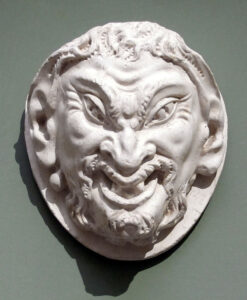
The Head of a Faun is considered to be Michelangelo Buonarroti’s first known work of sculpture in marble. Sculpted when he was just 15 or 16 years old, it was created as a copy of an antique work with some minor alterations. The original sculpture has since been lost, but reproductions and depictions remain, leading to much interest and study in art history.
Depicting an old, bearded faun-like face, Michelangelo imparted to the head a fantasy absent from the ancient sculpture. The faun deity was significant in its usage for the Cult of Bacchus, making it all the more captivating. The head of a faun embodies classical aesthetics that were highly significant during Renaissance times.
This piece was created while Michelangelo attended the San Marco Garden school of art founded by Lorenzo de’ Medici. Its magnificence attracted the attention of Lorenzo himself who marked Michelangelo as someone with enormous potential in the field. Nowadays, Head of a Faun holds special significance among sculptures considering it is tied to one artist’s early career triumphs that set him on his path towards fame and fortune.
2. Crucifix (1492)
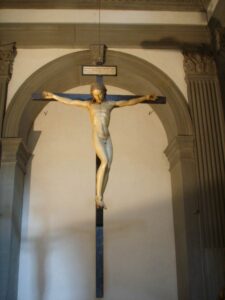
Michelangelo is known for his incredible skill in sculpting the human form, and his Crucifix sculpture is a masterpiece that exemplifies this expertise. The polychrome wood sculpture was lost from view until it re-emerged in 1962. In 2001, new investigations appeared to confirm the attribution of this work to Michelangelo. It was made for the high altar of the Church of Santo Spirito di Firenze in Florence, Italy.
The Crucifix theme introduced by Michelangelo showcases perfect proportions, despite not having an iconic muscular portrayal. He was famed for his knowledge of human anatomy and conveyed this through the subtle details on Christ’s body. The sculpture was possibly done by Michelangelo when he was a teenager and is believed to have been donated by a private collector to the Louvre in Paris.
Art historians identified this work found in the sacristy of Santo Spirito with the wooden cross mentioned by early writers. There are two different crucifixes attributed to Michelangelo, but neither is universally accepted as his. This makes it difficult to determine which one might be an authentic piece made by him.
3. Battle Of The Centaurs (1492)
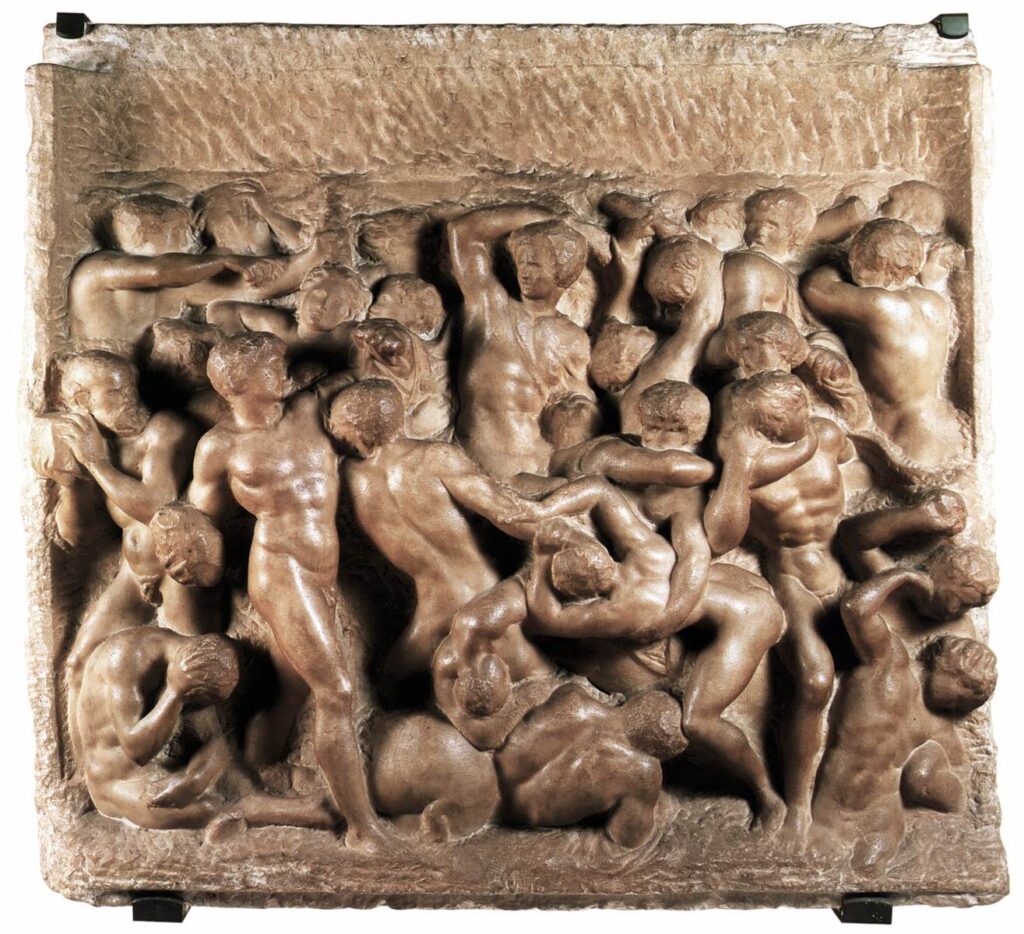
Battle of the Centaurs is a relief sculpture crafted by Michelangelo in 1492, which depicts the mythical war between Lapiths and Centaurs. The sculpture was commissioned by Lorenzo de’ Medici and remained unfinished until it was completed by another artist, Bartolomeo Vivarini. Michelangelo’s Battle of the Centaurs is an early work showcasing his love for human anatomy. Scholars believe that this masterpiece could have been carved using a bow drill; however, it was created using a chisel.
Legend has it that Michelangelo was inspired to create Battle of the Centaurs after hearing about the mythological battle from scholar and poet Poliziano. The fact that this artwork remained incomplete for centuries could be attributed to Lorenzo’s sudden death, as he was one of Michelangelo’s primary patrons. Regardless, Michelangelo held this sculpture in high regard throughout his life.
Battle of the Centaurs marked a significant milestone in his career as he transitioned from a young apprentice into an established artist under Lorenzo de’ Medici’s tutelage. Despite being unfinished, this work showcases his attention to detail and ability to carve marble with extraordinary precision at such a young age.
4. Madonna Of The Stairs (1492)
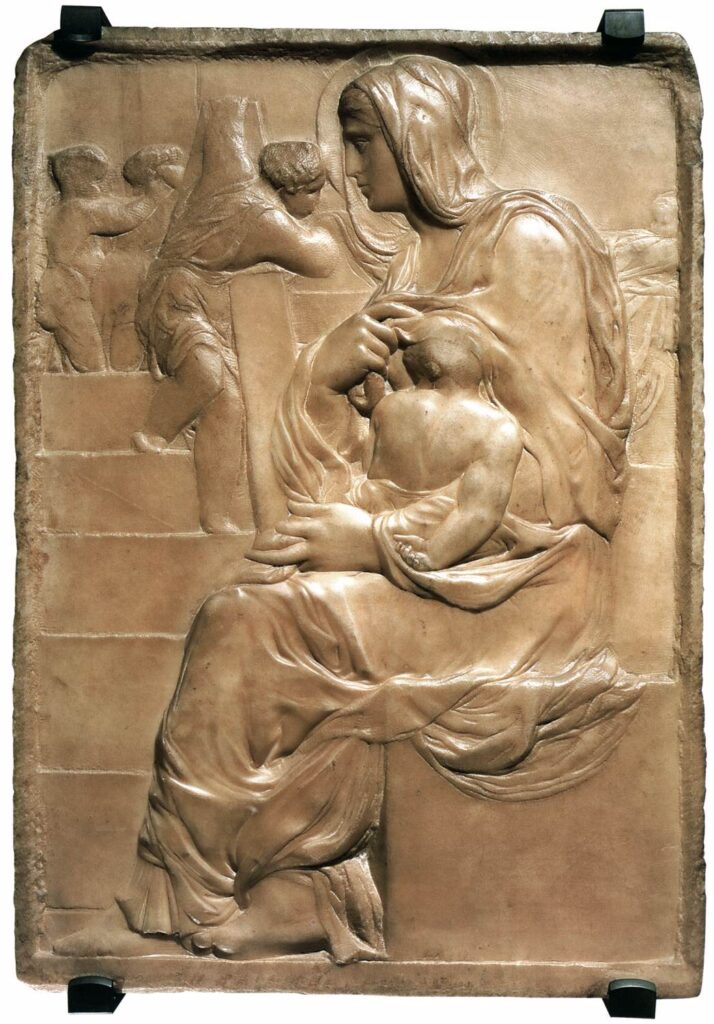
Madonna of the Stairs is a low relief sculpture created by Michelangelo around 1490. It can be found at Casa Buonarrati in Florence, Italy. This piece exhibits Michelangelo’s genius as he used his chisel to make three-dimensional figures seemingly pop out of the marble background.
The artwork depicts the Virgin Mary sitting on a set of stone stairs with three figures standing in the backdrop. Her child, Jesus Christ, is held on her lap whilst nursing. The infant sits gracefully on Mary’s legs and holds onto her veil while looking at something beyond the viewer’s sight.
One exceptional aspect of Madonna of the Stairs is how Michelangelo employed classic sculpting techniques used by Donatello and Brunelleschi to create depth in his sculpture. He also utilized shading effects to catch observed light and add dimensionality to his work.
This sculpture was part of Michelangelo’s earliest production together with the Battle of Centaurs created around a comparable time as this work between 1490-92. Although it has been restored more than once, including adding support brackets that did not exist when it was first made, its originality makes it one of Michelangelo’s most treasured works.
5. Hercules (1492)
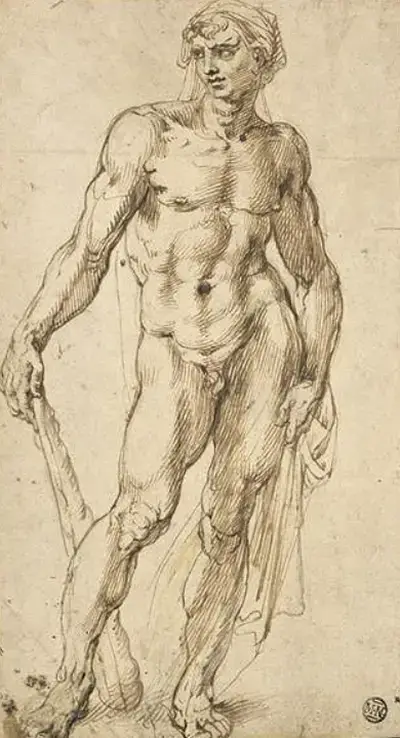
Michelangelo, the renowned Italian sculptor, carved an 8-foot-tall marble statue of Hercules in 1492. Sadly, the sculpture has been lost and has not been seen since 1713. Nevertheless, historians understand its significance from records of its movement throughout history. The statue of Hercules was a major work for Michelangelo during his early years and showcased his exceptional talent for sculpting.
In 1528-29, Michelangelo turned a large block of cheaper marble into a stunning 7.7 ft statue of Hercules that still impresses art enthusiasts today. Interestingly, there is controversy surrounding who may have transported this second sculpture to France or if Michelangelo himself took it there as payment for designing the fortifications around Florence.
Although we don’t know what the “lost” Hercules looked like precisely, there are drawings and bronze sculptures attributed to Michelangelo depicting this legendary figure. Besides being able to see influences from Classical Antiquity in these works, art historians can also discern Michelangelo’s own unique style and character as well.
6. St. Petronius (1494)
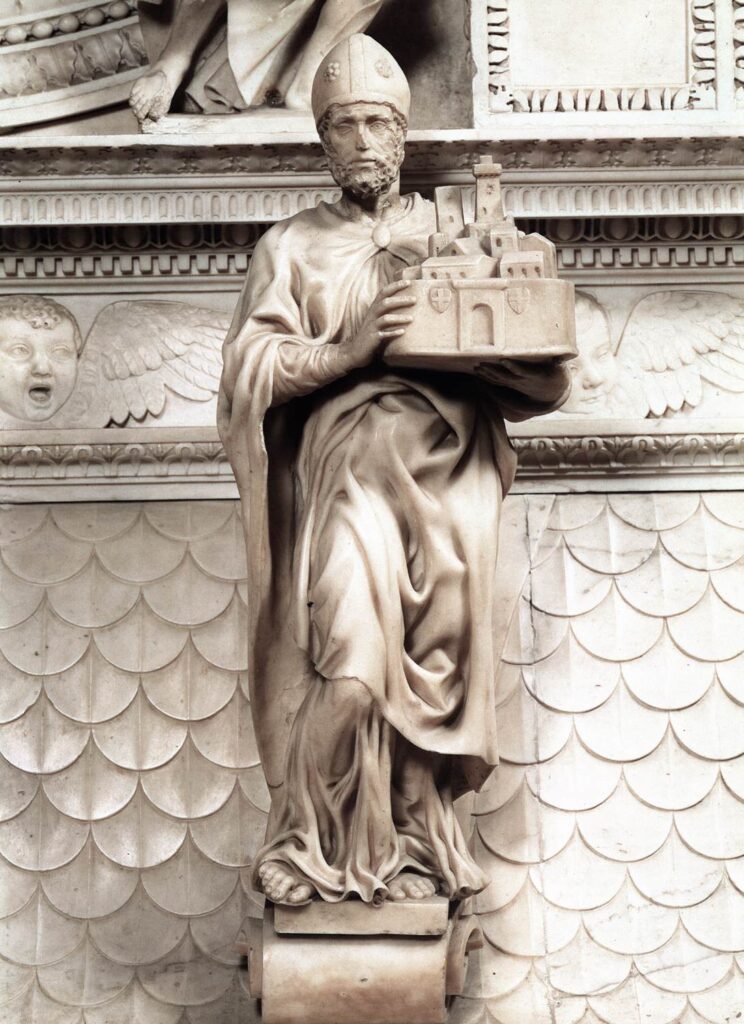
Michelangelo’s St. Petronius sculpture was created in 1494-1495 and currently stands at 64 cm in height. The statue is located inside the Basilica of San Domenico, Bologna, and depicts Saint Petronius holding a miniature model of the town he served as bishop. Michelangelo incorporated the “morphological Ferrarese rage” style, seen in paintings throughout Bologna, into his design for St. Petronius.
The sculpture was commissioned along with two others as part Arca di San Domenico project which had been started previously but stopped due to poor craftsmanship. Michelangelo was hired to complete St. Petronius while creating the remaining sculptures from scratch; these included depictions of St. Proculus and an Angel.
St. Petronius carries a miniature model of Bologna while having detailed carvings on his robe’s beard and chest area indicating movement forward. This depiction adds further detail to this sculpture made out marble using Michelangelo’s artistic abilities at that time are echoed by how much care went into carving each little feature that gives life to this original piece still standing intact today after many centuries passed since its creation..
7. St. Proculus (1494)
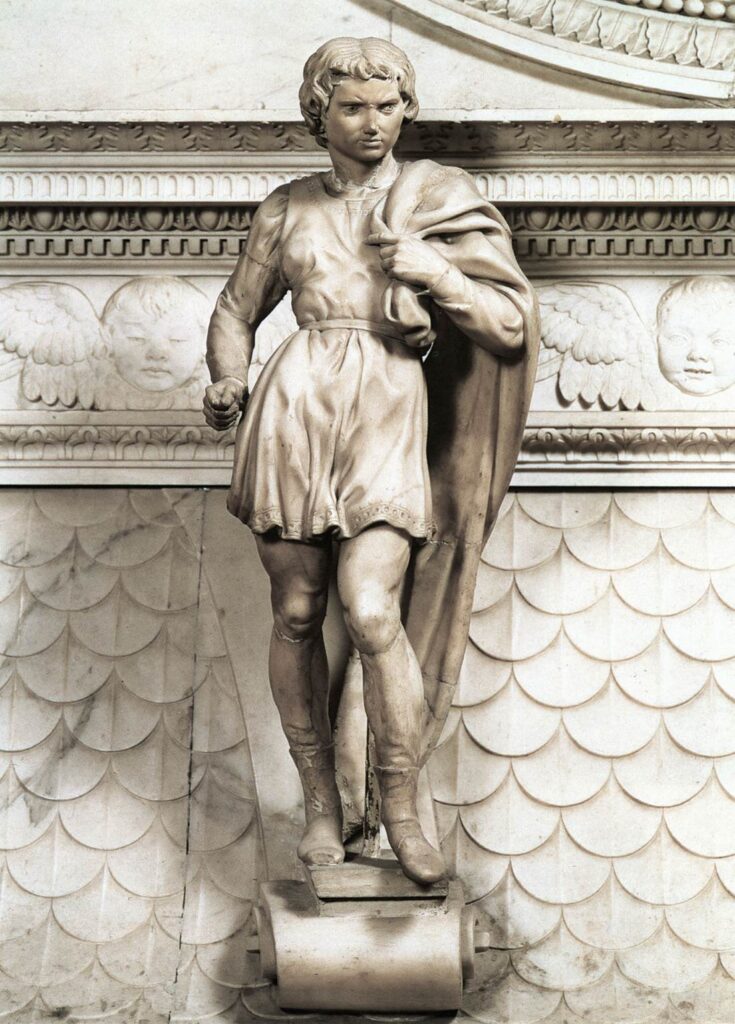
Michelangelo’s sculpture of St. Proculus is a masterpiece created in 1494 out of marble. The statue measures 58.5 cm and was commissioned by the Basilica of San Domenico in Bologna. St. Proculus is depicted standing confidently, with his cape draped over his left shoulder in a pose that echoes the styles of Masaccio and Donatello.
St. Proculus was a martyr from Bologna, and Michelangelo’s sculpture portrays him in an impressive manner befitting his heroic status. This piece is one of Michelangelo’s earlier works which he completed while working on the remaining sculptures for the arca (tomb) of St. Dominic after its original artist passed away.
Michelangelo infused his unique style into this creation, which would foreshadow some of his more significant sculptures such as David and Moses later on. The craftsmanship skills reflected it being one of many great achievements accomplished by Michelangelo during his tenure as one of history’s greatest sculptors.
Overall, Michelangelo’s sculpture Of St Proculus showcases both his exceptional skill in creating realistic human figures plus reveals how profoundly religion infused art back then when faith combined with talent to create masterful pieces still celebrated today all around the world!
8. Tomb Of St Dominic (1494-1495)
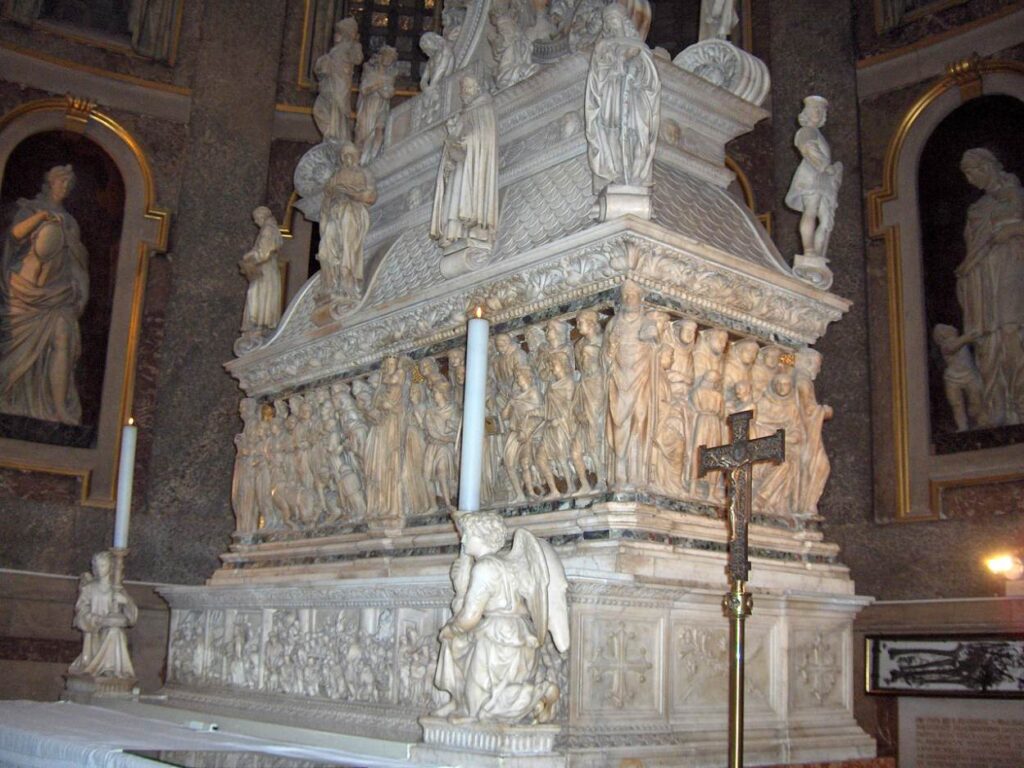
The Tomb of St. Dominic is a remarkable sculpture, which was commissioned in the 13th century and took around half a millennium to complete. The tomb incorporates some of the finest marble sculptures from Italian artists, such as Nicola Pisano and Michelangelo. Michelangelo was tasked with completing the tomb by sculpting three figures, namely St. Proculus, St. Petronius, and an angel with a candelabrum.
The statues that Michelangelo sculpted are made of small marble pieces that are now kept inside the Basilica of San Domenico in Bologna. It is important to mention that these sculptures were part of a larger decoration project for the Ark of Saint Dominic designed during his early artistic years between 1494 and 1495.
Apart from these relatively small sculptures, there is also a fresco worth mentioning within the tomb’s architecture – The Glory of St. Dominic on the apse’s cupola- depicting how St Dominic ascends into heaven bestowed upon by Guido Reni’s brushwork; this has earned it its place as one of Italy’s most treasured art sites.
After five centuries in construction, The Tomb was finally placed on an altar made out entirely of marble in the 18th century – now forever standing tall as testament to how long it takes to produce true works-of-art often remain timeless across time itself when history treasures them so immensely.
9. Angel With Candlestick (1494-95)
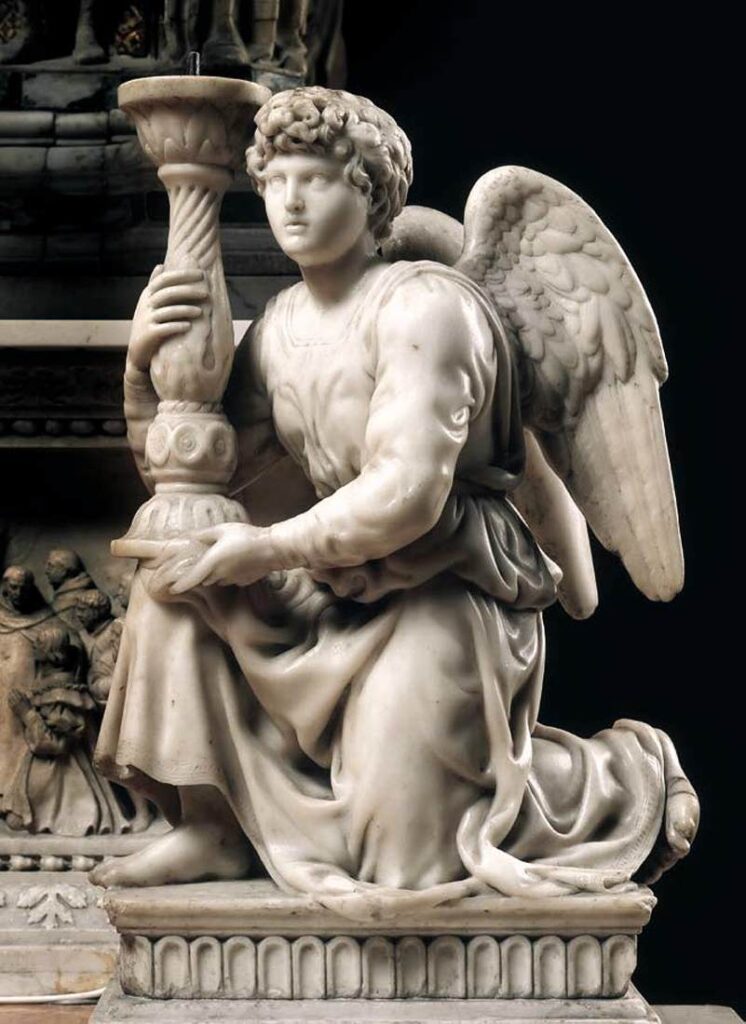
Angel with Candlestick is a significant sculpture in the career of Michelangelo, created in High Renaissance style. The statue depicts a youthful angel kneeling on one knee, holding a large candlestick. It is believed that Michelangelo created this work when he was just 17 years old, making it one of his earliest works as an artist.
The sculpture showcases the classic Renaissance style, with well-proportioned and muscular anatomy of the angel’s body. The angel has short curly hair and exudes confidence, with the intensity on his expression highlighting his divine qualities. The wings are also detailed perfectly to reflect their strength and power.
Commissioned by Bologna’s Church of San Domenico back in 1495 as a companion piece to Niccolo dell’ Arca’s similar angel sculpture for Arca di San Domenico. It was made to adorn the Arca di San Domenico shrine which serves as an ornate tomb for Saint Dominic, who founded the art-promoting Dominican Order. Located at Basilica of San Domenico in Bologna till date where it still amazes its visitors.
10. Bacchus (1497)
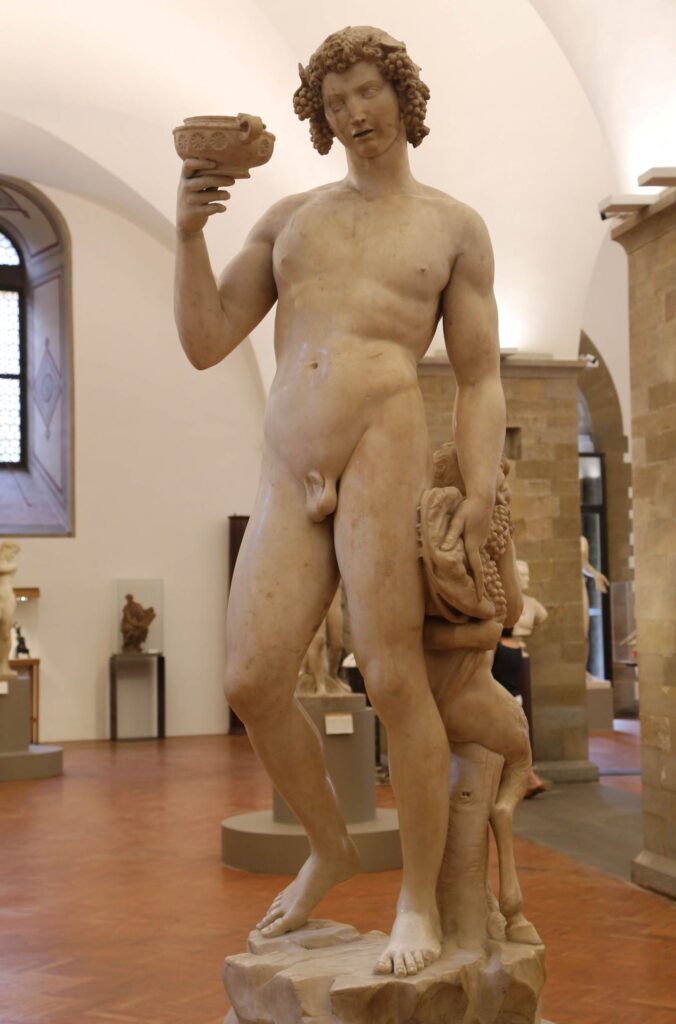
Michelangelo’s Bacchus (1497) is a marble sculpture of the Roman god of wine that stands at 203 cm tall, 76 cm wide and 86 cm deep. Commissioned by Cardinal Raffaele Riario for the Palazzo della Cancelleria in Rome, it remains one of Michelangelo’s earliest sculptures carved in Rome. The sculpture showcases Michelangelo’s talent and love for marble.
The statue portrays Bacchus holding a large cup of wine in his right hand while being depicted naked and inebriated. The sculpture is deemed controversial due to its overall subject matter and style, particularly concerning Bacchus’ expression which some artists describe as an epitome of blasphemy.
Today, Bacchus (1497) can be viewed at Room 3 of the Bargello Museum in Florence where it stands out among other exhibits displayed within the same gallery section dedicated exclusively to Michelangelo sculptures.
11. La Pieta (1499)
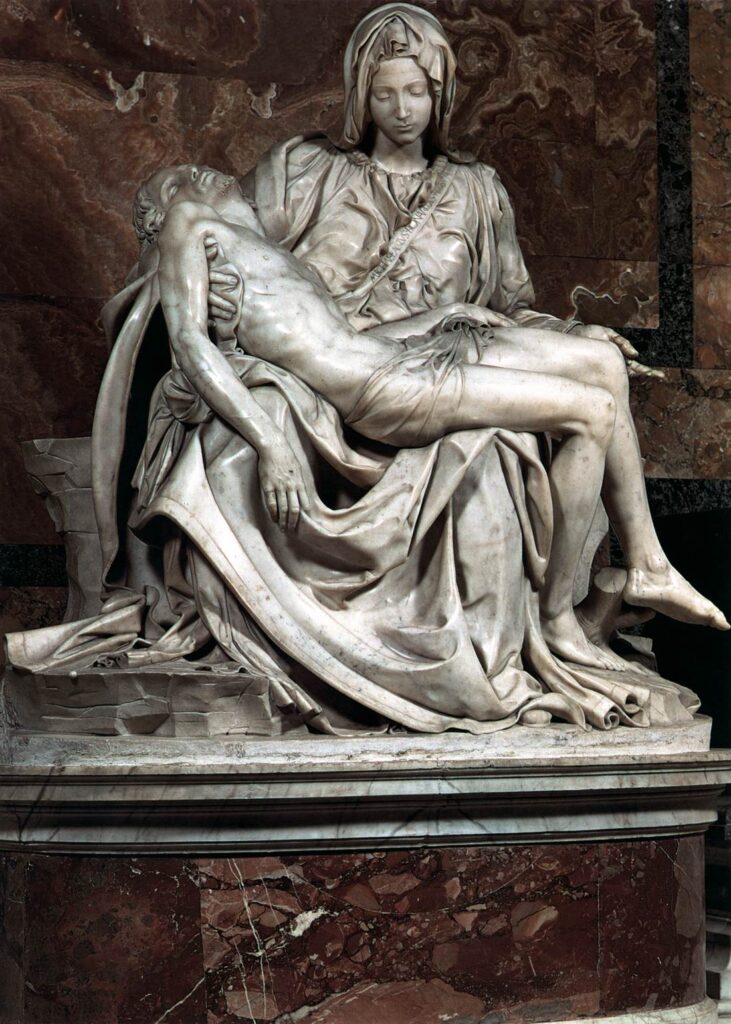
La Pietà, a marble sculpture of Jesus and Mary, is one of Michelangelo’s most remarkable works. The artwork features naturalism and classical beauty in perfect balance, making it iconic in the world of art. La Pieta translates to “pity” or “compassion,” reflecting Mary’s sorrowful gaze over her son’s lifeless body held on her lap.
Michelangelo crafted this stunning masterpiece from a single slab of Carrara marble. The pure blue-and-white stone was named after the Italian region where it is mined. Unsurprisingly, the artist used his remarkable talent to make sure every curve of the figures was exceptionally detailed and lifelike.
Commissioned by French Cardinal Jean de Bilhères back in 1498 while he was representing Rome, Michelangelo completed La Pietà when he was just 24 years old. He must have poured all his emotions into every carve since it is among his first major works that is signed.
La Pieta stands as an example of high Renaissance art movement that happened in Europe during the fifteenth and sixteenth centuries. This timeless artwork continues to inspire people today as they contemplate its breathtaking details and meaningful portrayal of grief-stricken Mary staring at her deceased son’s serene face.
12. Madonna And Child (1501-05)
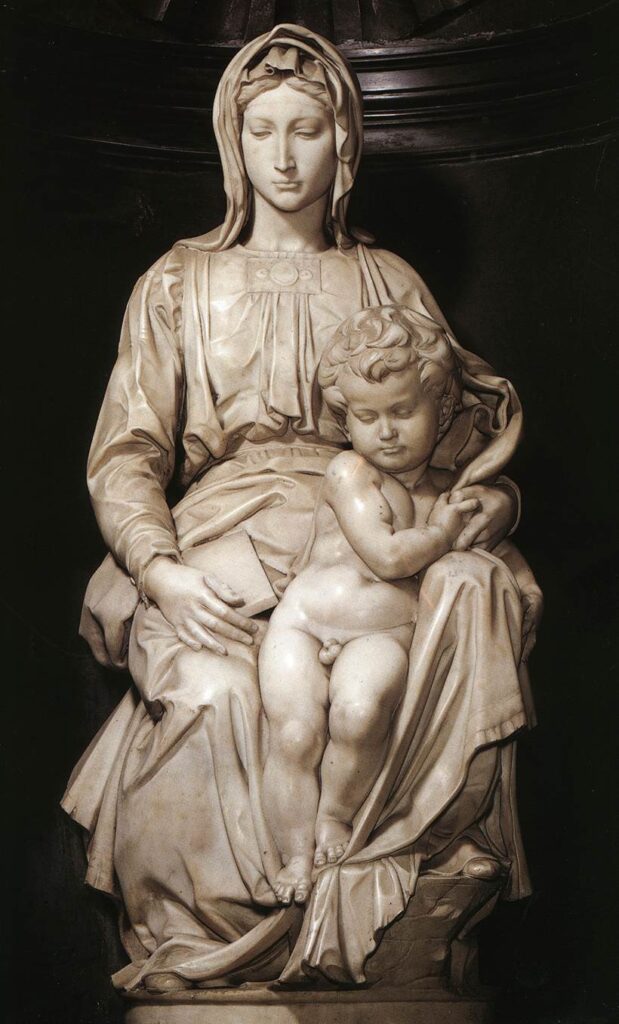
Michelangelo’s “Madonna and Child” sculpture, created between 1501-1505, depicts a unique portrayal of the Virgin and Child. Unlike previous representations of the subject, Michelangelo chose to feature a sad-looking Madonna holding her child in a tense position, creating an air of vulnerability around the piece. This foreshadows the sorrowful theme later used by Michelangelo in his works and was unlike anything seen at that time.
The Italian merchant Angelo Doni commissioned this marble sculpture for his wife Maddalena Strozzi during Michelangelo’s early years as an artist in Florence. This first sale abroad helped solidify Michelangelo as one of Europe’s most respected artists. It is probable that he took inspiration from Donatello’s work earlier sculptures in similar styles.
During World War II, it was stolen by Nazi forces and kept in salt mines near Altaussee until Monuments Men recovered it alongside other missing artworks after the war. Today, it can be found at the Church of Our Lady of Bruges for viewing purposes.
13. St Matthew (1503)
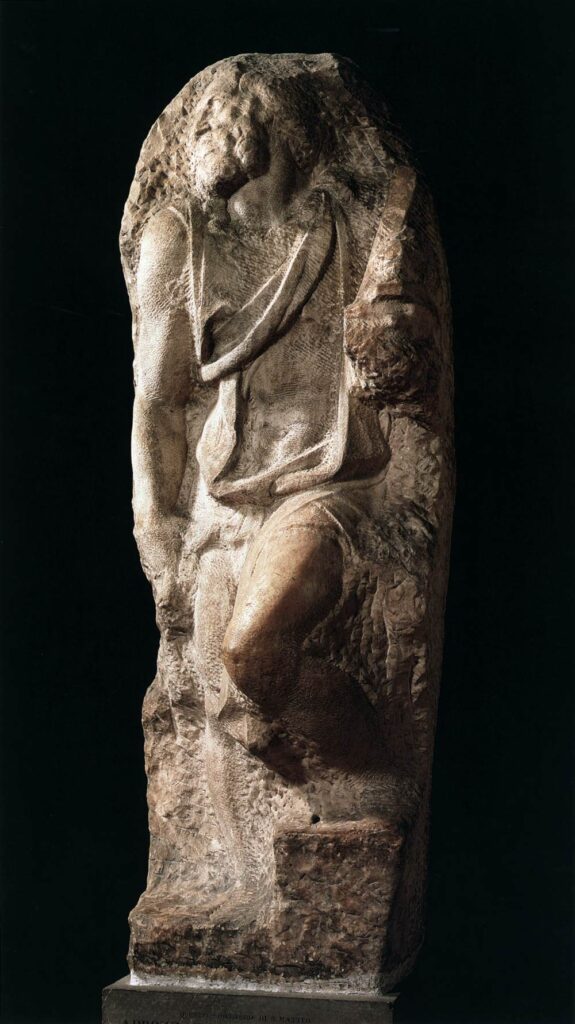
St. Matthew is a marble sculpture of Matthew the Apostle created by Michelangelo between 1503 and 1505 in Florence. The statue was intended to be one of twelve apostles for the choir niches of the Florence Cathedral, but was left unfinished in 1506 when Michelangelo moved to Rome to work for Pope Julius II.
The sculpture depicts St. Matthew sitting down with his head turned towards his left hand, which holds a book upon his lap, symbolizing knowledge and wisdom. His right hand rests on his knee with fingers elegantly extending downwards, directing visitors’ attention towards the book beneath it.
What stands out about this piece is its twisting composition that subtly suggests movement even while frozen in marble. The figure of St. Matthew is torqued around its central axis giving it life far different from traditional statues; a spasm of movement rather than stillness.
One can also notice Michelangelo’s striking juxtaposition by placing an animated Christ Child whose subtly-twisted body appears enclosed and protected between Virgin’s legs and arms while she stands calmly over him like a guardian angel depicted as cool and hieratic.”
14. David Of Michelangelo (1504)
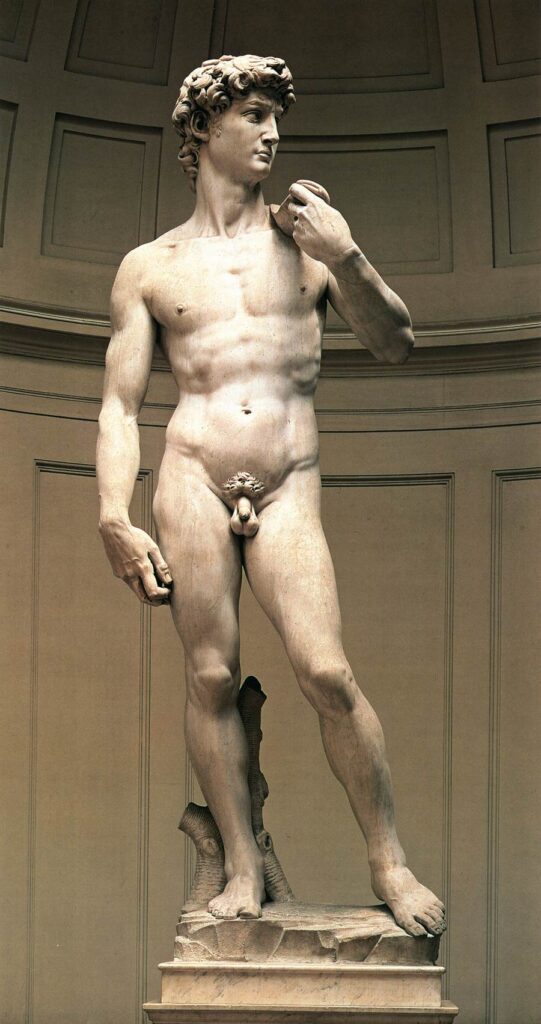
David of Michelangelo is a marble sculpture originally executed between 1501 and 1504. Standing at 17 feet tall, it’s one of Michelangelo’s most famous works. The statue portrays David, a biblical hero who battles Goliath. In the sculpture, David stands patiently, his expression one of deep contemplation as he prepares to take on his enemy. He grips a slingshot in one hand while holding the stone that will ultimately defeat Goliath in the other.
The sculpture took Michelangelo two years to complete and was finished in 1504. During those years, he not only created an incredibly lifelike physical representation of David but also imbued him with psychological tension and depth. A careful consideration of the light and shadow illuminates every nuance of this masterpiece.
Michelangelo’s David is widely regarded as one of the greatest sculptures ever made by human hands; it embodies the aesthetics that are typical of High Renaissance art. Furthermore, even more than 400 years after it was made, David remains a source of inspiration for many artists in various fields today.
In summary, Michelangelo’s masterpiece “David” is a true work of art that skillfully captures both physical realism and psychological depth. With its attention to detail like no other artwork before it or since then in sculptures history , “David” is clearly an iconic piece that will always be linked to the best period in artistic history- The High Renaissance era .
15. Madonna (Pitti Tondo) (1504-05)
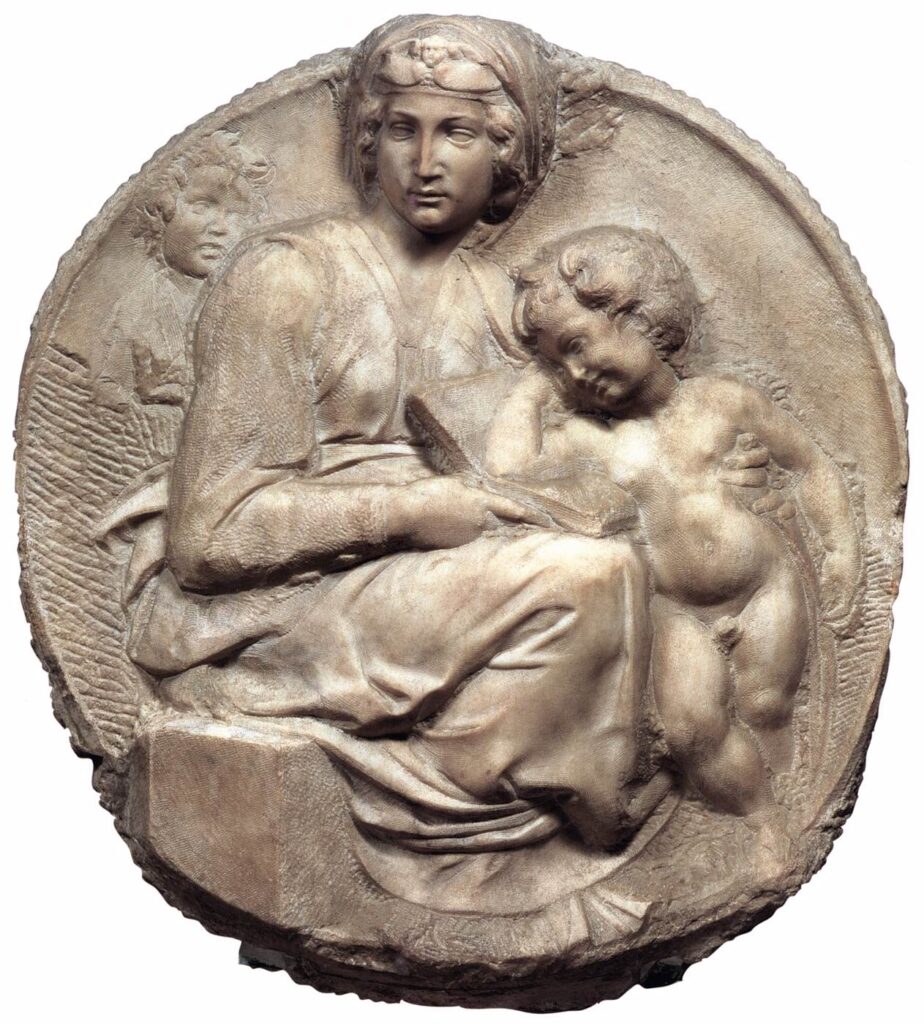
The Madonna (Pitti Tondo) is an unfinished marble relief of the Virgin and Child created by Michelangelo between 1503 and 1504. The sculpture is in round or tondo form and now on display in the Museo nazionale del Bargello in Florence. Michelangelo’s composition places the Madonna seated on a stone, with her forward edge projected towards the viewer, while she looks as if she is reading a book until her son Jesus Christ interrupts her by placing his elbow on it, supporting his head.
The fine chisel marks used to create the Pitti Tondo make the faces come alive, showcasing Michelangelo’s exceptional skill at carving marble. The figures look full of life despite being carved from stone. The Madonna sits on a block of low stone that fills up most of the composition, emphasizing how grand yet naturally serene this sculpture is.
This piece showcases not only Michelangelo’s extraordinary talent but also his unique approach to religious art through which he managed to infuse sculptures with human-like characteristics despite its innate rigidity – with very few reliefs branching out into three dimensions such as in this unfinished work. It further highlights how different it was from other works at that time; its realism brought about new meaning to conveying spiritual messages outside formal religious iconography standards prevalent during its creation.
In conclusion, Michelangelo’s Madonna (Pitti Tondo) remains an iconic sculpture that reflects both his incredible talent and visionary creativity in shaping religious art forms so profoundly impactful even till today.
16. Madonna And Child With The Infant Baptist (Taddei Tondo) (1505-06)
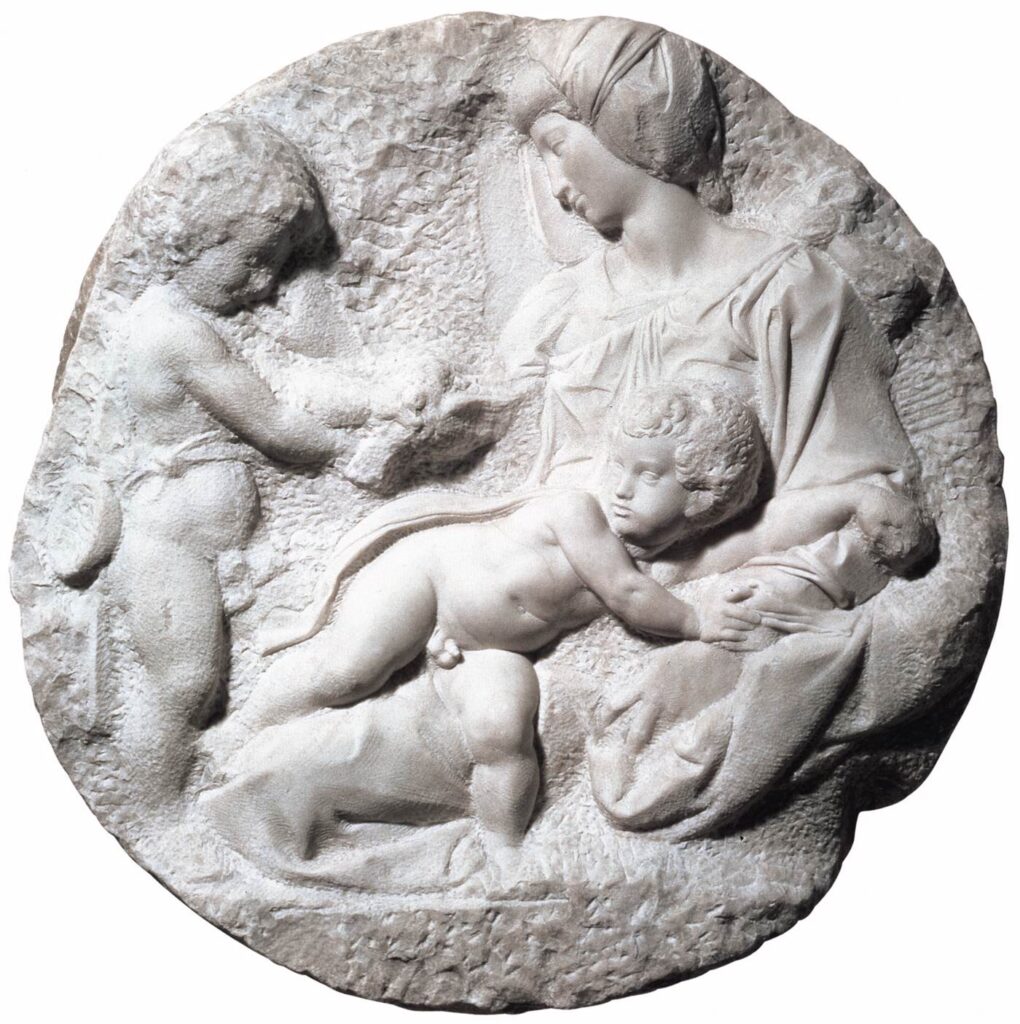
The Taddei Tondo is a stunning marble relief tondo of the Madonna and Child and the infant Saint John the Baptist, sculpted by Michelangelo Buonarroti. It is currently the only marble sculpture by Michelangelo in a UK collection. Commissioned by Taddeo Taddei, it remained in the Casa Taddei, Florence until the early-nineteenth century. Sir George Beaumont purchased it in 1822 and later bequeathed it to the Royal Academy. This masterpiece depicts Madonna and Child with an Infant St John placed in a rocky landscape which was uncommon for art at that time.
Michelangelo’s approach to exploring problems related to composing circles was evident in this masterpiece – he defined relationships within picture space precisely while handling various spatial planes effectively. The subtle use of chiaroscuro techniques can also be seen here as he skillfully played with lighting effects on different textures around his subjects to create depth.
Through this piece, Michelangelo managed to balance intricate details with strong rhythms evident from his treatment of drapery folds and aureoles surrounding madonna’s head as well as child’s thigh positions leftfoot closer more prominent than right foot making one think about movement despite being carved out of rock.
17. Slave (rebelling) (c. 1513)
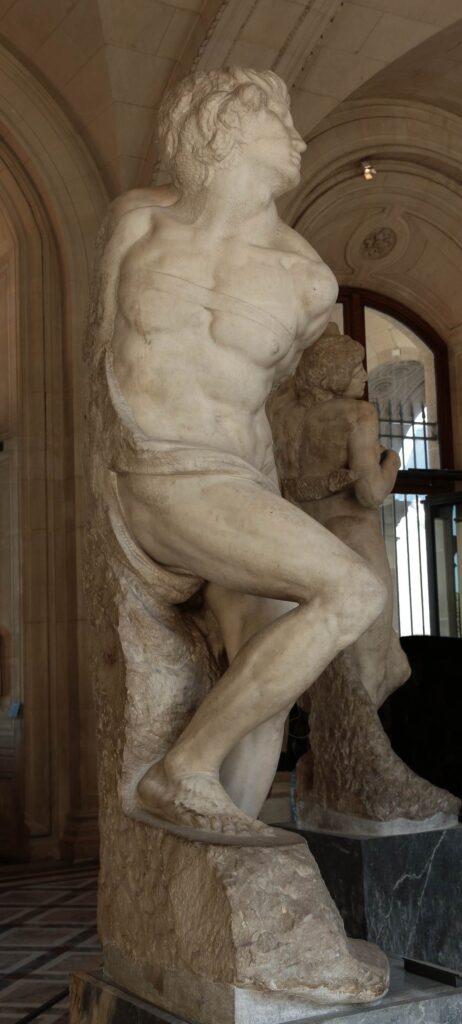
The Rebellious Slave is a famous sculpture created by Michelangelo in 1513. It stands at 2.15 meters tall and is made of marble. The figure’s arms are tied behind his back, giving the impression that he is struggling against his restraints and yearning for freedom. He appears to be twisting in a dynamic spiraling movement which projects his left shoulder forward and tilts his head upwards.
It was intended for Pope Julius II’s tomb alongside five other slaves Michelangelo had crafted, but the tomb project was eventually scaled down by the Church, leaving the sculptures in storage. This sculpture, along with The Dying Slave, were eventually bought by France in 1794 and are now held at the Louvre Museum in Paris.
Despite being considered unfinished, The Rebellious Slave is often admired for its striking realism and emotional depth. It has been speculated that Michelangelo intentionally left it incomplete to symbolize the struggle of humanity towards an unattainable ideal of freedom.
18. Moses By Michelangelo (1513-1515)
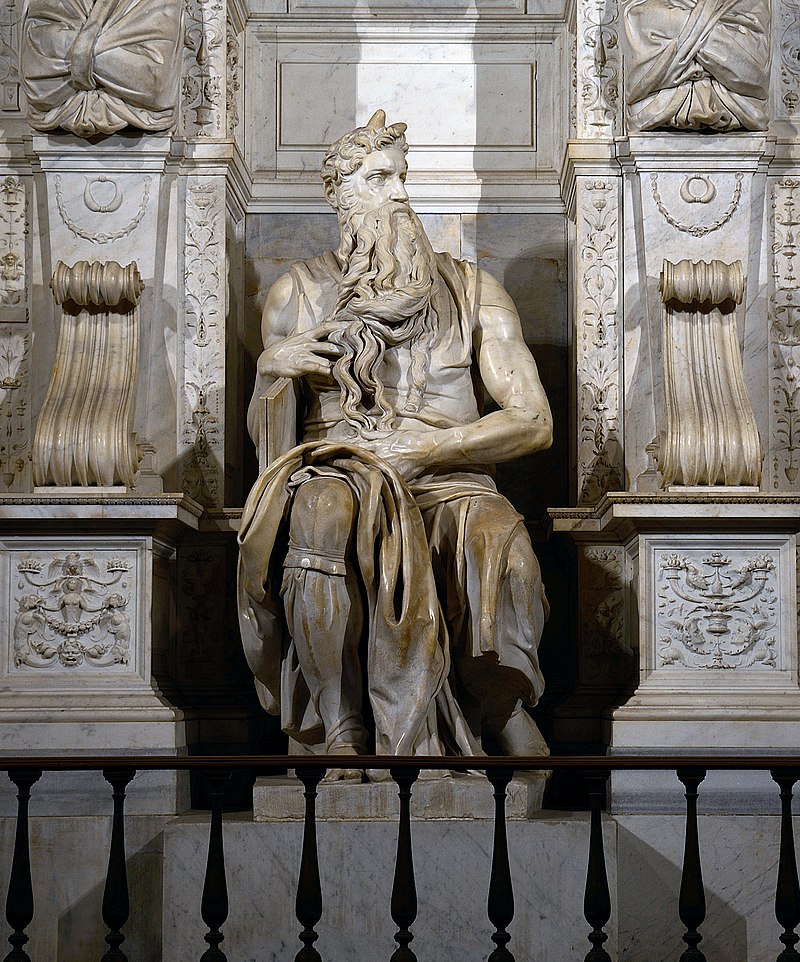
Michelangelo’s Moses sculpture is a true masterpiece of the Italian Renaissance. This monumental sculpture can be found in the church of San Pietro in Vincoli, Rome. The sculpture was intended to be part of Pope Julius II’s tomb and was originally meant to be placed at a height of 3.74 meters above the ground.
The statue depicts a seated Moses holding the Tablets of the Law under his right arm. Michelangelo’s astonishing talent brings this work to life, creating an almost palpable sense of flesh and blood out of cold marble. One noteworthy detail is Moses’ facial expression, which conveys both anger and misery.
Interestingly, this magnificent work may have been an inspiration for other artists beyond Michelangelo’s immediate circle. For instance, it could have influenced Edmonia Lewis, a renowned black female sculptor who gained fame during the same period as Michelangelo through her works depicting notable figures such as Abraham Lincoln and Robert Gould Shaw.
20. Dying Slave (1516)
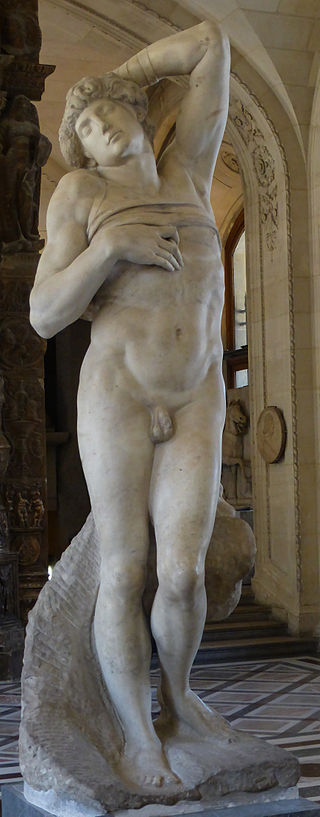
Michelangelo’s Dying Slave sculpture was created between 1513 and 1516 to serve with another statue, the Rebellious Slave, at the tomb of Pope Julius II. The sculpture is held at the Louvre Museum in Paris and stands 2.15 meters tall. It is considered an unfinished piece of work by Michelangelo and portrays a state of bondage and extreme constraint.
The youth in the Dying Slave sculpture has a strong but delicate body that is characterized by a standing pose with his left arm raised to his curly head. Michelangelo used formal principles such as an ascending spiral to give the figure dynamic movement. The sculptor also demonstrated his ability to make marble appear like living flesh and blood through meticulous carving techniques.
The Dying Slave actively portrays human resistance against slavery, which was an important subject during Michelangelo’s time. This theme can be seen in many of Michelangelo’s works, including sculptures like Moses and paintings such as The Last Judgment. Despite its unfinished status, the Dying Slave remains one of Michelangelo’s most significant works for its representation of timeless themes that are still relevant today.
21. Slave (young) (1519-36)
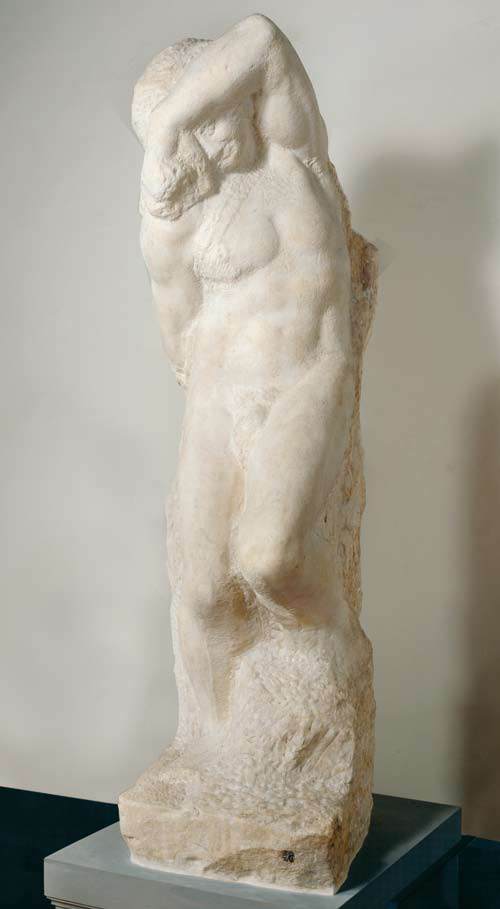
The Young Slave was a marble figure designed by Michelangelo for the unfinished tomb of Pope Julius II, which underwent many changes. The sculpture captures a state of bondage, portraying a strong desire for spiritual and political freedom. It is currently displayed as a sketch model at the Academia in Florence.
This masterpiece showcases Michelangelo’s exceptional skills as a sculptor. The Young Slave’s physical features convey raw emotions while depicting an ongoing struggle with captivity. He is depicted as muscular and well-toned, yet in chains, perhaps hinting at the internal conflict he faces due to his enslavement.
Michelangelo had intended this artwork to be part of Pope Julius II’s grand tomb project. However, the pope’s death marked an end to the project and left this piece incomplete. Nevertheless, even in its unfinished state, it still remains one of Michelangelo’s most significant contributions to art history.
22. Slave (awakening) (1519-36)
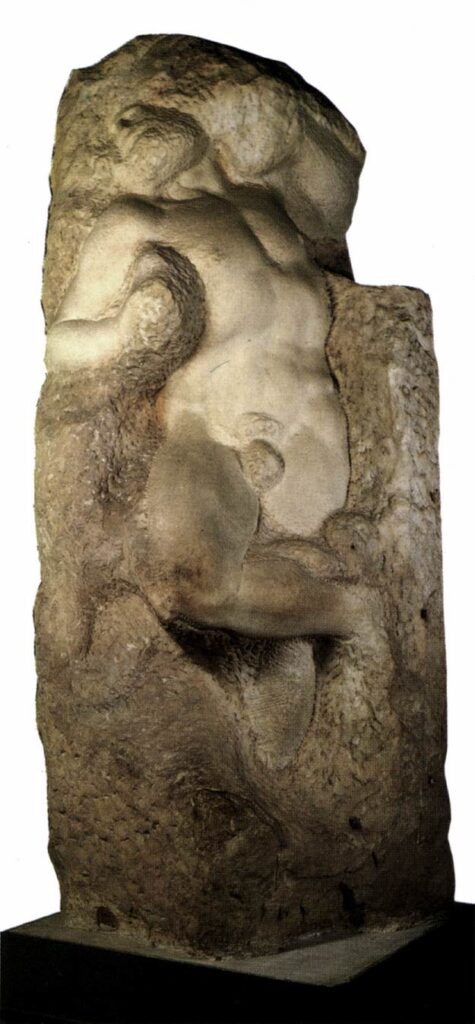
Michelangelo’s ‘Slave (Awakening)’ is a remarkable sculpture made from marble dating from 1519-36. The incomplete piece is part of the series known as the ‘Prisoners,’ which was commissioned for the Tomb of Pope Julius II. This particular slave sculpture shows a man who appears to be emerging from his imprisonment, his arms and legs still partially embedded in the stone.
The characters of Michelangelo’s Slaves have been interpreted as representational symbols, personifying categories such as intellect or inspiration, but also express a political message about freedom. The sculptures comment on humanity and seek to tap into our emotions with their unfinished form suggesting that we too are incomplete until we attain self-realization. Michelangelo uses these works to project ideas like sensual passion, strong willpower, and psychological introspection through plumbing psychological depths in his human figures.
Through this incredible piece of art, Michelangelo portrays an urge to break free; indeed, the figure seems determined to escape extreme confinement and shackles. Furthermore, he mastered an art form that made marble seem like living flesh within all statues he created with David being one of them. In conclusion, the Slave (Awakening) presents an excellent specimen that highlights Michelangelo’s sculpting prowess while also addressing fundamental socio-political issues that persist till now.
23. Slave (bearded) (1519-36)
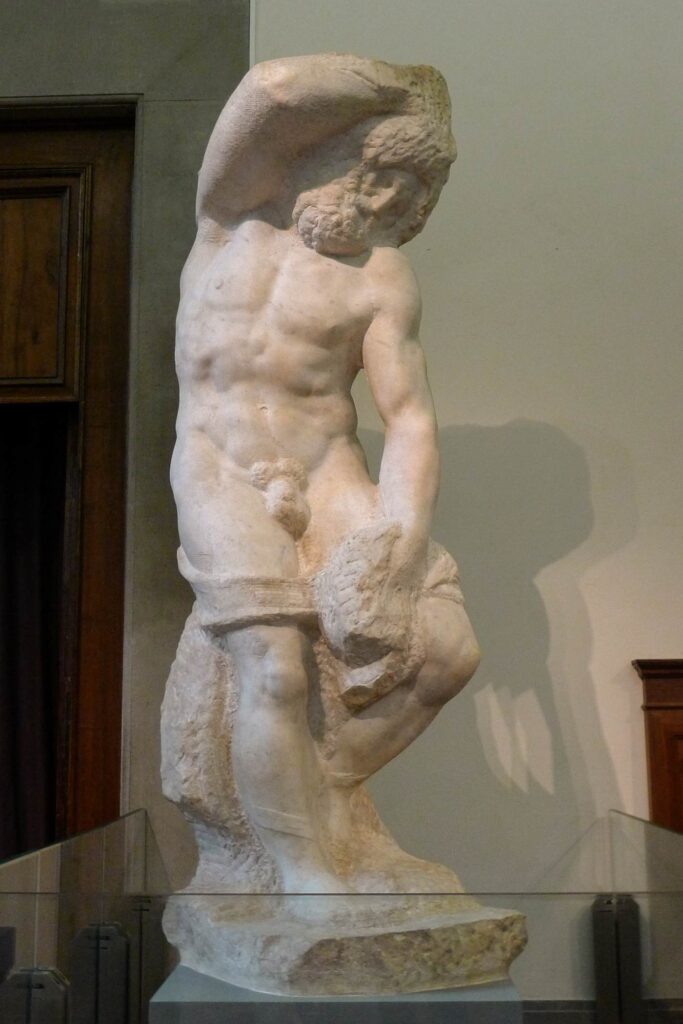
The Bearded Slave is a marble sculpture created by Michelangelo during the years 1525-1530. Displaying a thick beard and muscular physique, this sculpture was part of a group of sculptures called Prigioni or Slaves intended for Pope Julius II’s tomb. The Bearded Slave was likely to be placed in front of a pilaster on the left side of the tomb’s center.
Michelangelo was known for his ability to evoke emotion and movement within stone, as exemplified in The Bearded Slave. This sculpture embodies an animalistic inferiority that emphasizes humanity’s spiritual connection between body and soul. While all Figures prepared for the Julian monument have certain massiveness, The Bearded Slave has rougher proportions than its peers.
The Bearded Slave (1519-36) displays Michelangelo’s mastery skills in sculpting as it portrays physical power and movement in life-like form. It is made from white marble and stands over two meters tall. The captive figure whose soul is embodied by chains to their subjugated self can be interpreted with an emotional struggle that emanates from within the stone itself.
Overall, The Bearded Slave is not only a masterpiece but also an excellent representation of Michelangelo’s artistic technique during his career as one of the most renowned Italian Renaissance artists ever known globally.
24. Slave (Atlas) (1519-36)
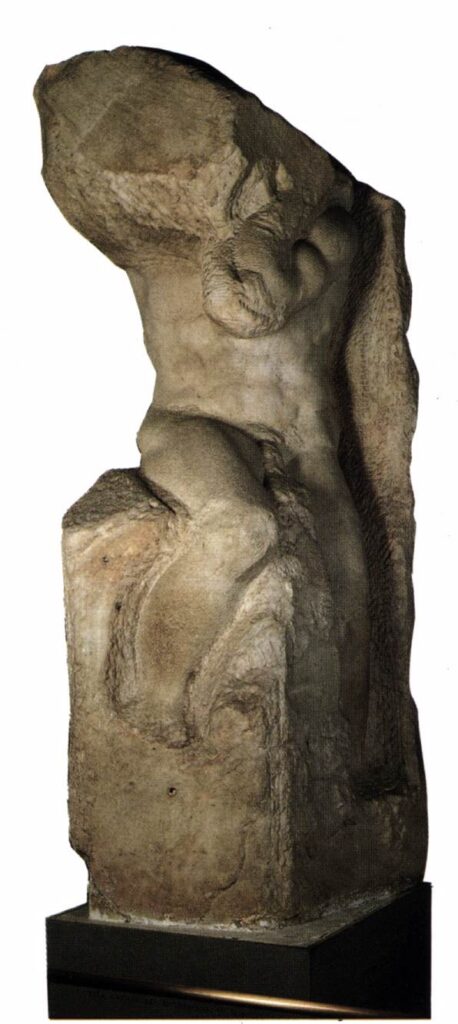
The Atlas Slave is one of the most famous sculptures created by Michelangelo during the 16th century. This masterpiece was made using marble, stands at a height of 2.77 meters and dates back to 1525-1530. The sculpture is part of a series of unfinished artworks called the ‘Prisoners’, which were originally intended for use on the tomb of Pope Julius II.
It is held in the Galleria dell’Accademia museum in Florence today and remains an inspiration for many art enthusiasts all around the world. The statue has been interpreted from various angles, with some experts believing that it represents Neoplatonic allegories of human struggles to free themselves from bondage.
Furthermore, Atlas Slave highlights Michelangelo’s artistic style and techniques through his firm grip on movement depicted throughout this sculpture. Its use of male anatomy to demonstrate pure strength and power has been used inspiringly in other instances throughout modern history as well such as heroic actions against adversity or personal oppression among others – showcasing Michelangelo’s timeless legacy even today.
25. Risen Christ (1521)
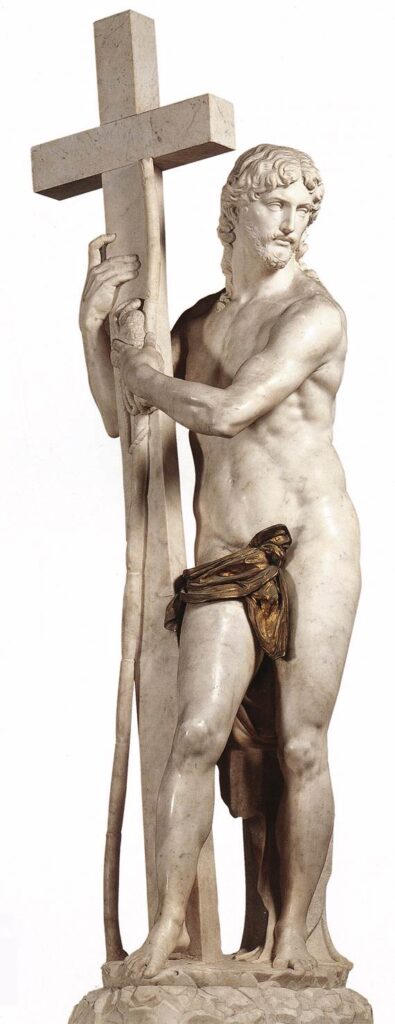
Risen Christ is a stunning marble sculpture by Michelangelo created in 1521. This artwork, located in Santa Maria sopra Minerva Church, Rome, depicts a standing naked figure of Christ holding the cross. Michelangelo initially had trouble working on the marble due to a black streak on the face. Despite this obstacle, it only took him four years to complete the sculpture.
The Risen Christ is an excellent representation of classical antiquity elements such as naturalism and contrapposto. The sculpture uses anatomical precision to create an emotionally charged work of art that highlights spiritual purity. Notably, Michelangelo’s contemporaries described it as profoundly beautiful.
Before scholars identified it as his work in 1997, Bernini was incorrectly attributed to creating this masterpiece. Commissioned by patrician Metello Vari, Michelangelo initially presented an incomplete version of the sculpture as a gift before finishing it off into its final form.
Risen Christ is considered one of Michelangelo’s best sculptures because its realism captures both humanity and divinity uniquely through vivid imagery that moves viewers emotionally and spiritually alike.
26. Apollo (1530)
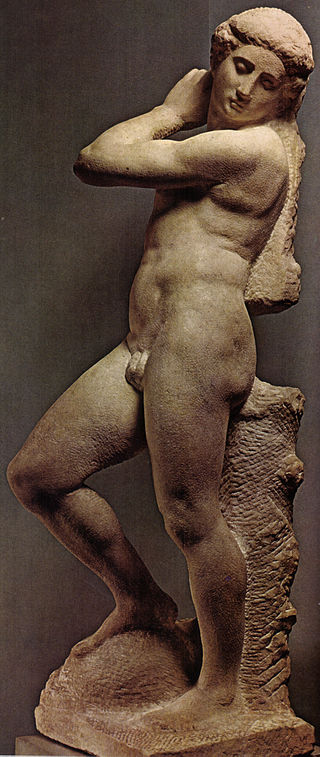
Michelangelo’s Apollo (1530) is an unfinished marble sculpture that currently resides in the Bargello museum in Florence. It has been speculated that the piece was originally intended to be David before Michelangelo repurposed it into Apollo.
Michelangelo, a renowned Renaissance artist also known as “il divino,” produced some of his most famous sculptures including Pietà, David, and Moses. All of them were known for their stunning attention to detail and emotional depth.
Despite being unfinished, Apollo still showcases Michelangelo’s signature style with its intricate musculature and realistic depictions of the human form. The figure stands tall and proud with his arm outstretched, evoking a sense of power and strength.
27. Lorenzo De Medici (1524-1531)
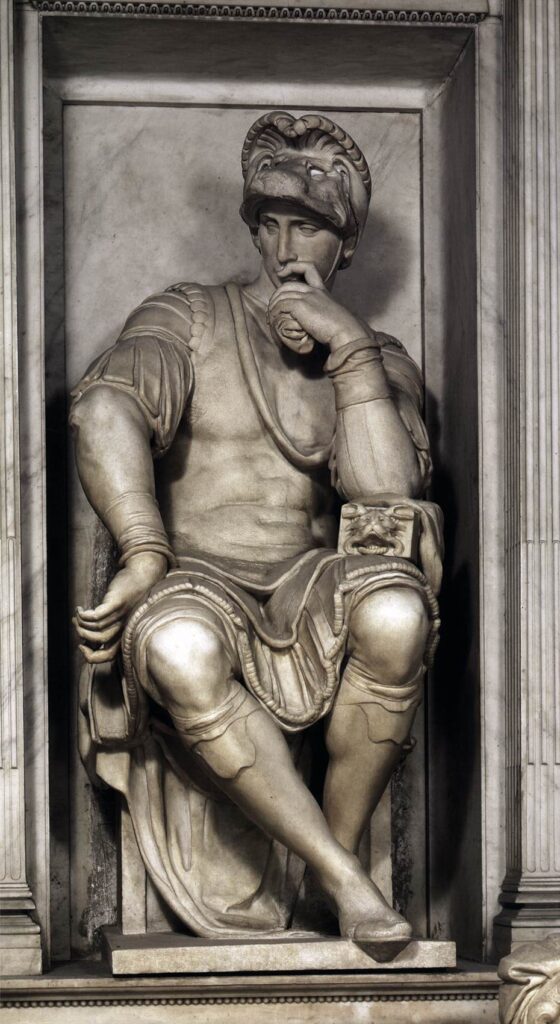
Michelangelo’s sculpture Pensieroso adorns the tomb of Lorenzo de Medici, Duke of Urbino in the Medici Chapel. This masterpiece offers an idealized portrait of Lorenzo II, who was a central figure in Florentine politics during the Renaissance. The figure of Lorenzo is seated in a niche above his tomb on which recline allegorical figures of Dawn and Dusk.
The commissioned burial chapel for the Medici dukes and princes Giuliano and Lorenzo was not only intended as a place for worship but also as a work of art. Michelangelo’s vision for this project was grand and ambitious, with numerous sculptures adorning the chapels’ walls. However, only six sculptures were ever completed due to funding shortages after several years of construction.
Later on, Giovanni Angelo Montorsoli and Raffaello da Montelupo executed sculptures depicting patron saints that were placed alongside Lorenzo’s tomb. These works represent Saint Cosmas, Saint Damian, Saint Francis of Assisi, and Saint Lawrence; all patrons commonly associated with 16th-century Florence.
28. Dusk And Dawn (1524-1531)
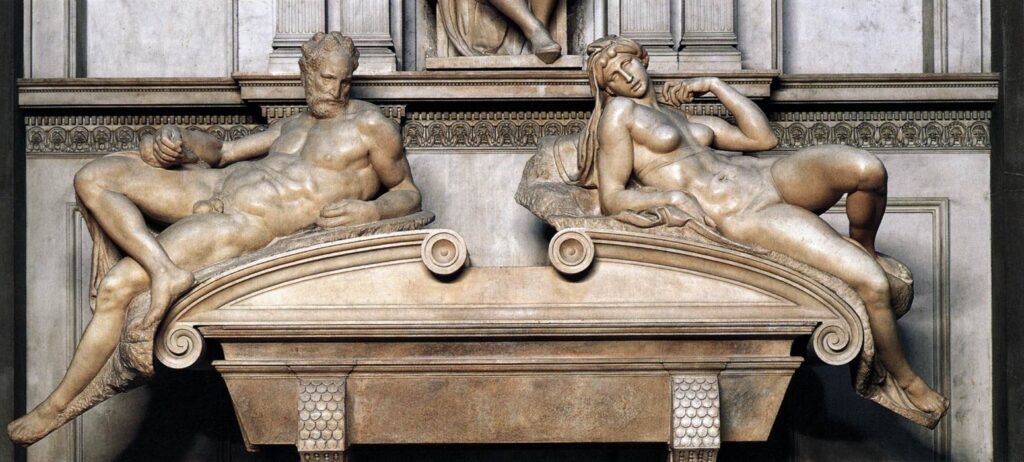
Dusk and Dawn are two stunning marble sculptures crafted by Michelangelo Buonarroti, renowned Italian artist. They were created between the years 1524-1531 as part of an allegory of the four parts of a day for the New Sacristy. These sculptures serve as a homage to Lorenzo II de’ Medici who commissioned Michelangelo to design the tomb.
Dawn and Dusk are gender-specific figures that accurately display their respective time of day. Italian grammar determined their gender; Dawn is a female figure while Dusk is male. Michelangelo’s pupils completed these works after he departed. The only nude sculpture ever created by Michelangelo, Dawn exudes purity with her virginal figure, while Dusk exudes calmness in his reclined gesture.
These beautiful sculptures can be found in the Medici Chapel situated at San Lorenzo in Florence and mark an important milestone for Michelangelo considering they were among his last sculpture pieces before he passed away at age 88. These masterpieces further cemented Michelangelo’s legacy as one of history’s finest sculptors with a mastery over marble that very few have ever been able to match.
29. River God (c. 1524)
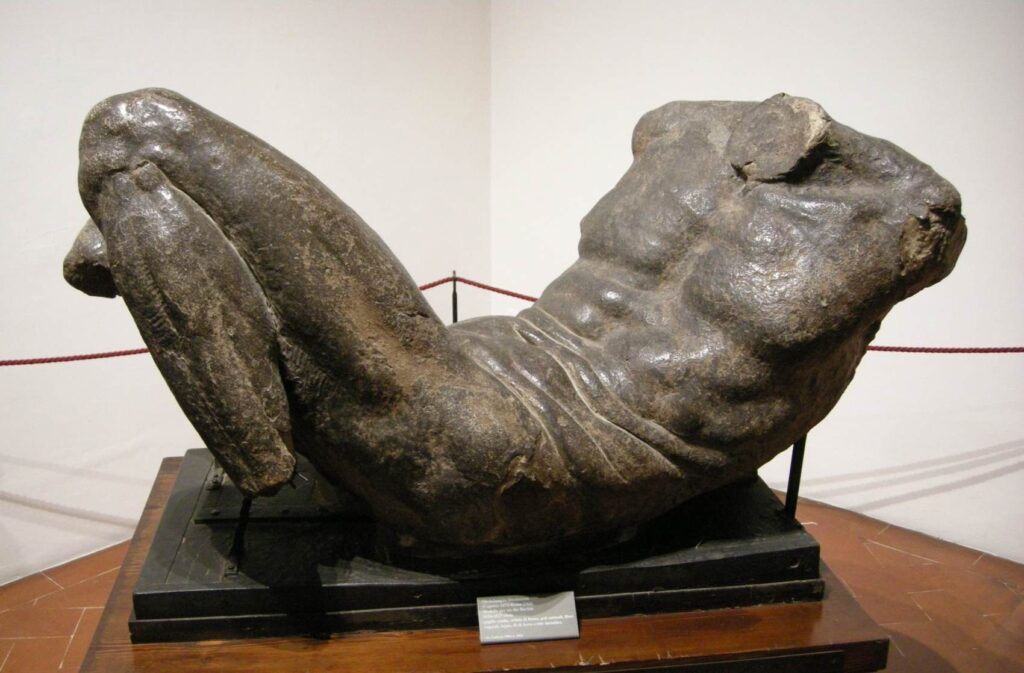
One of Michelangelo’s famous sculptures is the River God, created around 1525. It is a model for the God of the River and was commissioned by Cardinal Raffaele Riario. The model showcases a human torso, which serves as a preparatory rendition for other sculptures created by Michelangelo.
The River God survived from the New Sacristy in San Lorenzo, showcasing its significance in Renaissance art. Recently, Friends of Florence funded its restoration, allowing it to be displayed in one of Italy’s prestigious institutions – Accademia delle Arti del Disegno in Florence.
The River God sculpture demonstrates Michelangelo’s craftsmanship and attention to detail when it comes to creating realistic human figures. It also showcases his innovative approach to sculpting works that are moving and emotionally charged.
30. Night (1526-1533)
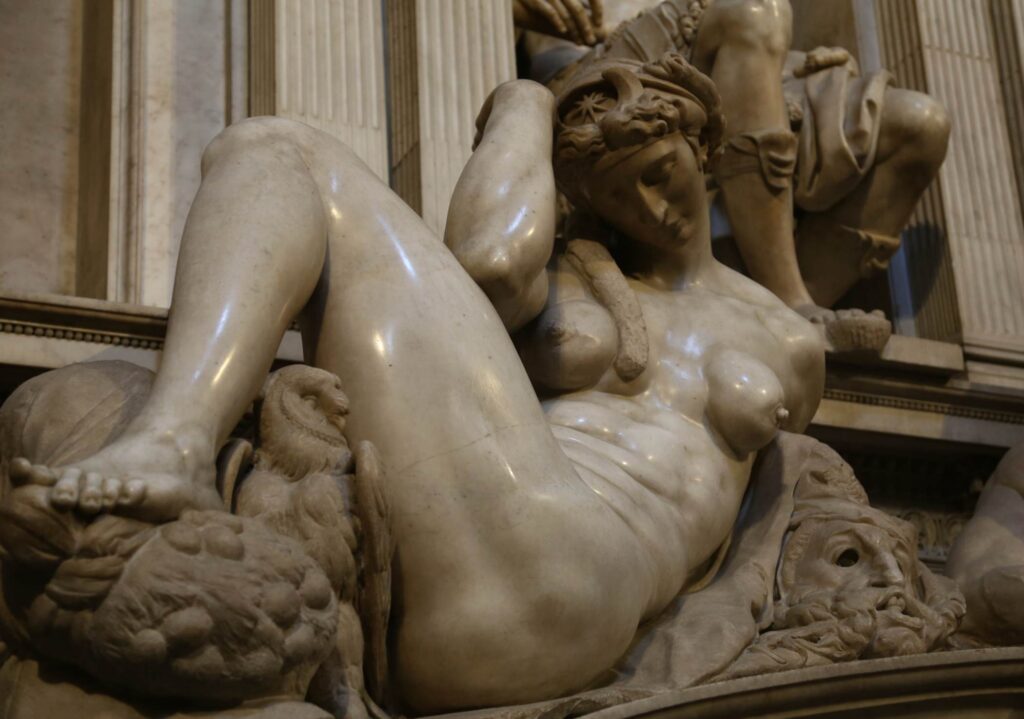
Michelangelo’s sculpture Night is part of the tomb of Giuliano de’ Medici, located in the Sagrestia Nuova of San Lorenzo in Florence. The sculpture depicts a sleeping figure resting her head below the right leg of Giuliano de’ Medici. Night has delicate features with a small face, closed eyes, and small pursed lips. It is made from marble and was created by Michelangelo between 1526-33.
Night is considered one of Michelangelo’s most significant sculptures as it showcases his ability to imbue inanimate objects with vitality and emotion. It embodies the wisdom of Black Mother night while maintaining an aura of peace and repose. The posture suggests that night follows day – it appears like she renews herself during the daytime for all humanity to use her again during nighttime.
31. Crouching Boy (1530)
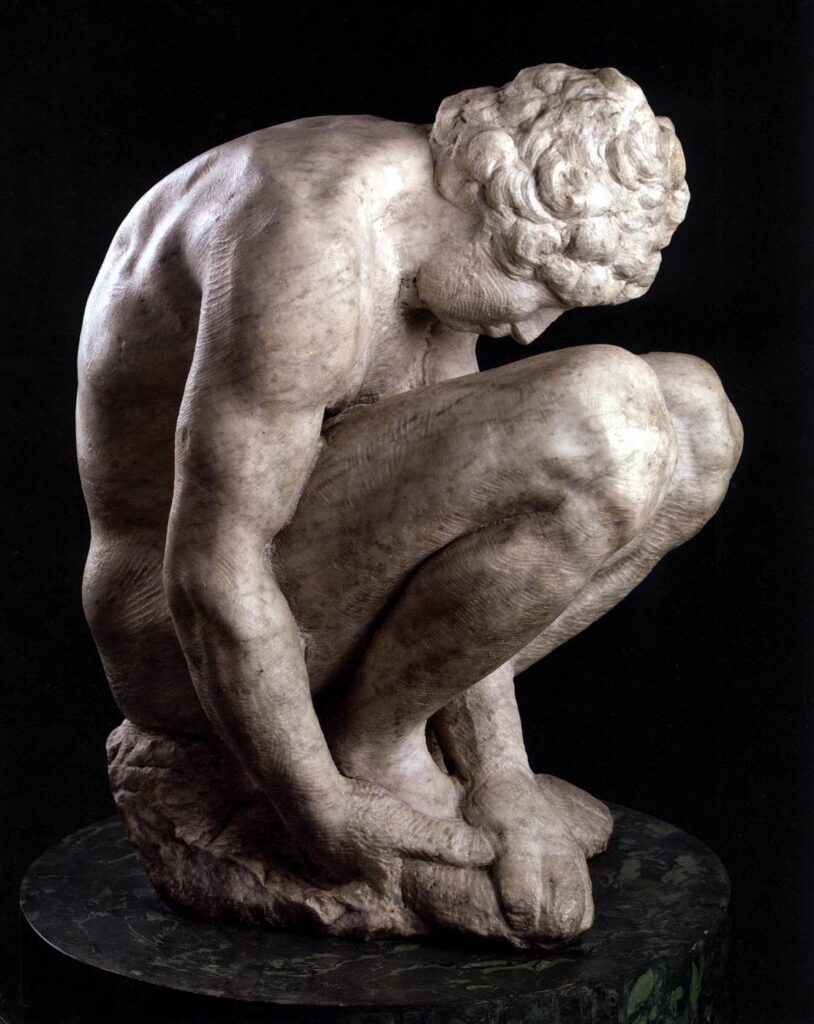
The Crouching Boy is a marble sculpture by Michelangelo, created in either 1524 or between 1530 and 1534. It is made from just over two feet of stone and depicts a naked boy turned in on himself, perhaps pulling a thorn from his foot. Despite its small size, the sculpture creates an impression of monumentality, unity, and inner force.
The statue was intended to be a supporting piece within the tomb of the Medici family but was not well finished. Facial features, hair, and body shapes are easily recognizable. It is currently housed in the Hermitage Museum in St Petersburg, Russia.
Considered one of the three most famous works by Michelangelo, this small model creates an incredible sense of depth despite its limited physical size. Its emotional force evokes pathos and empathy as it engenders responses reverberating across time and cultures.
32. Medici Madonna (1531)
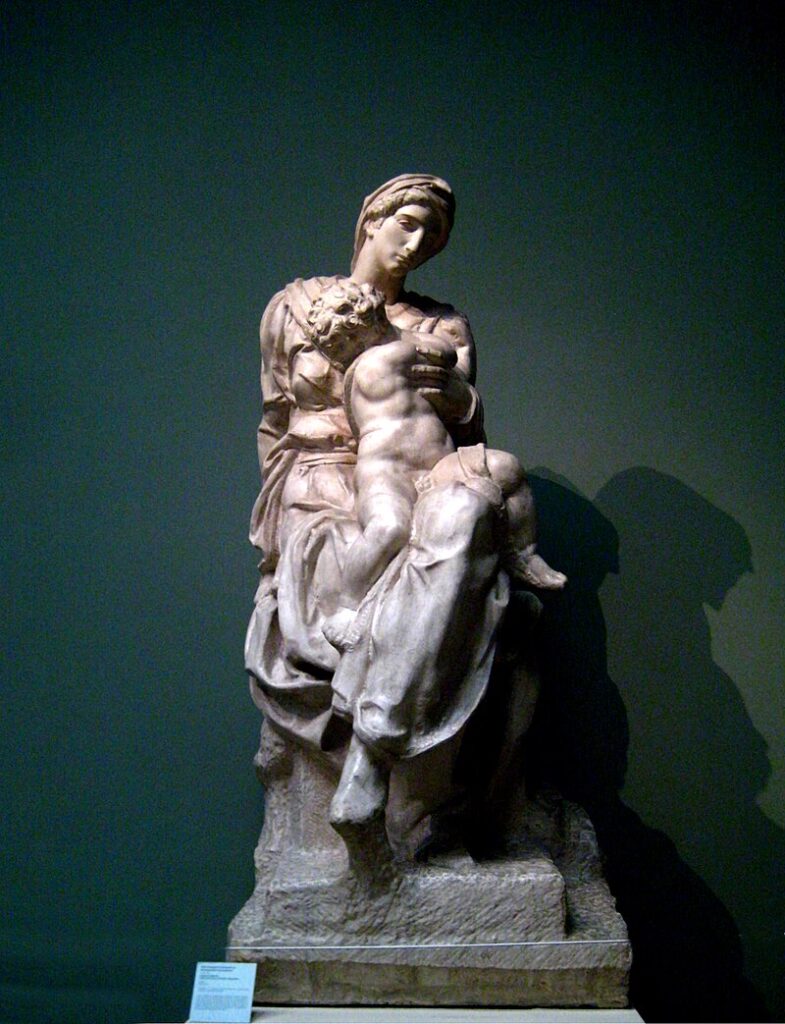
The Medici Madonna is a sculpture crafted by Michelangelo between 1521 and 1534 for the Medici Chapel in Florence’s Basilica of San Lorenzo. This sculpture depicts the Virgin Mary holding her son, the Christ Child, with little human interaction between them, despite their proximity. The statue was intended as decoration for the Old Sacristy and was placed above the tomb of Lorenzo the Magnificent and his brother Giuliano.
Michelangelo had a challenging relationship with the powerful Medici family, who held sway over Florence during his lifetime. They commissioned various artworks from him but also caused him to flee from Florence at one point due to political attacks against him.
33. Genius Of Victory (1532-34)
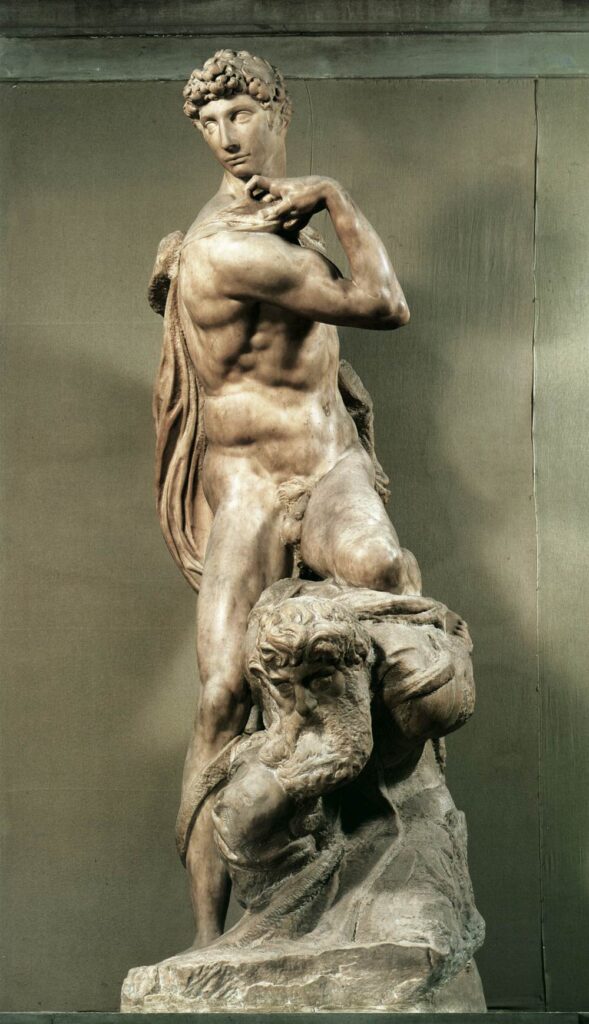
Michelangelo’s “Genius of Victory” is a marble sculpture created between 1532-34 as part of the design for the tomb of Pope Julius II. This 2.61m high sculpture is located in the Salone dei Cinquecento of the Palazzo Vecchio in Florence and represents a triumph scene where a young man, possibly resembling Michelangelo himself, conquers an older one.
This masterpiece showcases Michelangelo’s exceptional skills as a sculptor during the Italian Renaissance period. The strong manneristic features linked to his Slaves sculptures are evident in “Genius of Victory,” and it bears similarities with his renowned “David” statue. It’s a personification of virtue prevailing over vice, represented through dynamic movements and materialization given form by delicate chiseling.
The group’s significant lowering into the ground renders it more imposing as one enters under its front plane and sees its nearly crucial details from below. The Genius’ imaginative force rendered feasible by chalk lines may be viewed by looking up at them from this standpoint; indeed, their hurried immediacy lends lively energy to both figures’ twisting gestures that pivot against each other effortlessly.
34. Brutus (1538)
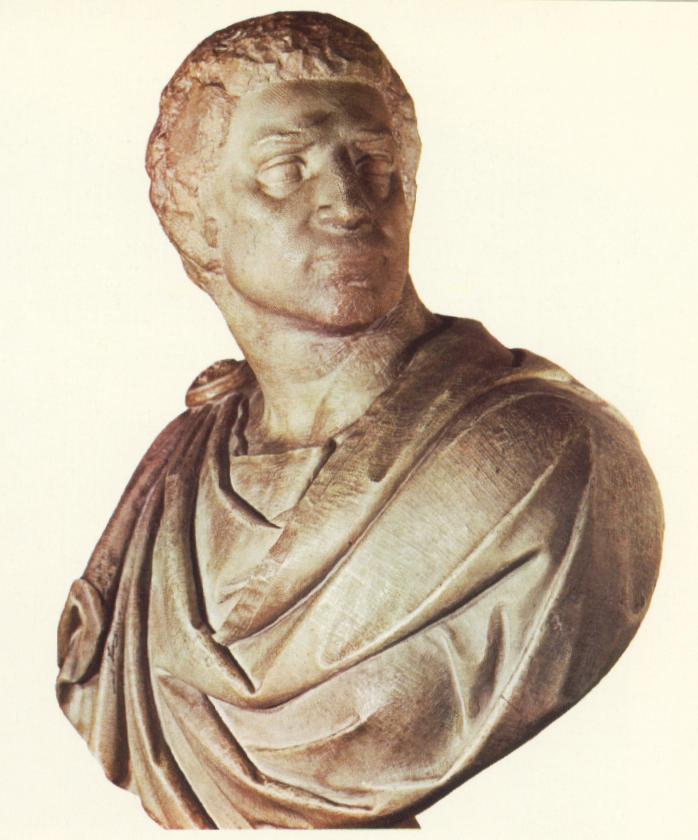
Michelangelo’s Bust of Brutus is a marble sculpture commissioned by Cardinal Niccolò Ridolfi and completed in 1538. It is currently housed in the Bargello museum in Florence, Italy. The sculpture portrays the Roman republican hero Brutus in a heroic aspect, representing the revival of the classical bust in sculpture during the High Renaissance.
Brutus was one of Michelangelo’s last works of primarily political significance. The piece is believed to be a sympathetic portrayal of Brutus, who famously participated in the assassination of Julius Caesar. The bust depicts Brutus with his hand resting lightly on his breast, perhaps representing his inner struggle to balance his loyalty to Rome and his personal relationship with Caesar.
The Bust of Brutus is an example of Michelangelo’s fascination with human anatomy and movement, as seen through its intricate details and realistic features. In addition to being a political statement, it is also considered an artistic triumph due to its magnificently executed details that reflect Michelangelo’s technical mastery.
35. Tomb Of Julius II (1545)
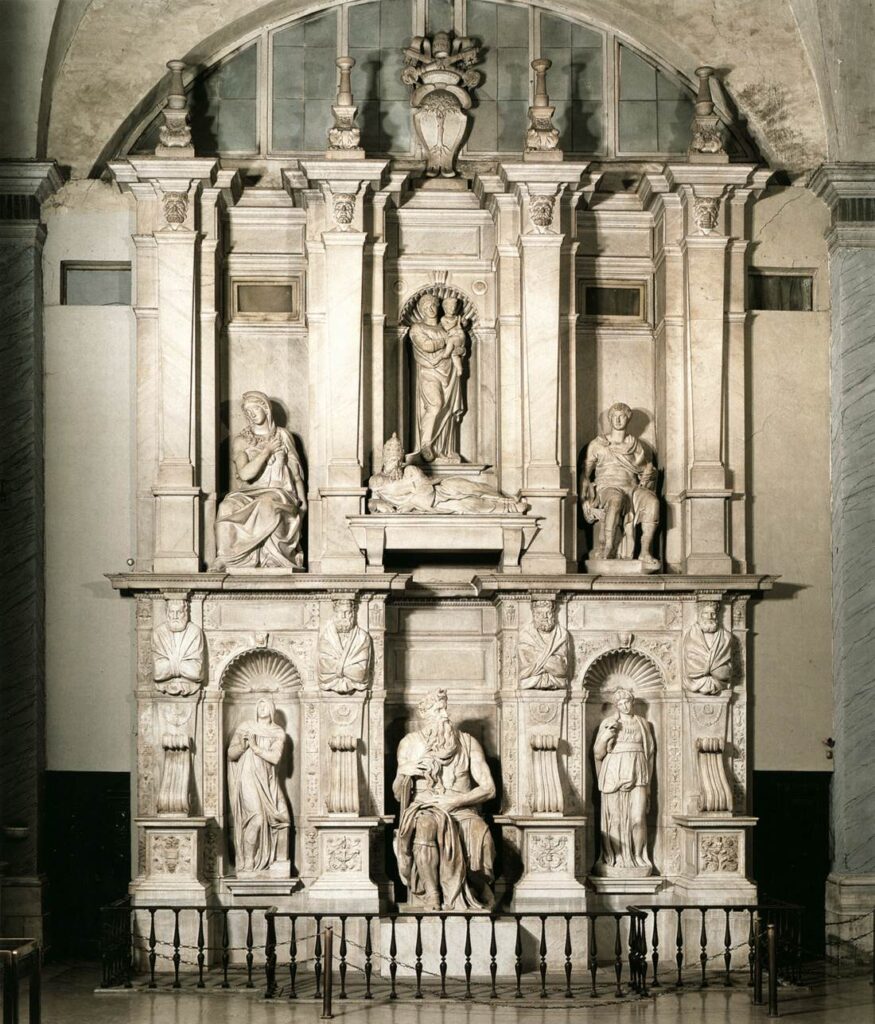
Michelangelo was commissioned in 1505 to create a grandiose tomb for Pope Julius II, which included 40 life-sized statues surrounding it. Originally intended to be completed in the span of five years, the artist only managed to finish a total of 12 statues before his patron’s death in 1513. Following numerous modifications and setbacks, including Michelangelo’s involvement in other projects such as painting the Sistine Chapel ceiling, the final rendition of the tomb was ultimately completed on a much smaller scale by 1545.
Although not fully realized as initially planned, Michelangelo’s creative output for the Tomb of Julius II left meaningful visual sources for artists who came after him. Two sculptures from the project which remain prominent are that of Moses and Leah. The former was created between 1513-1515 and became a summary of what was to be achieved by Michelangelo’s grand vision. On the other hand, Leah is one of two figures that completed decoration for the last version of Pope Julius II’s funeral monument done from 1542-1545.
Despite being scaled back significantly from its original design due to time constraints and financial complications, Michelangelo’s work on the Tomb of Julius II represented an important moment in Renaissance art history. It showcased his skillfulness as an artist and laid down groundwork for future artists to build upon with its visual inspiration and iconography even if it wasn’t realized completely as initially planned.
36. Rachel And Leah (1545)
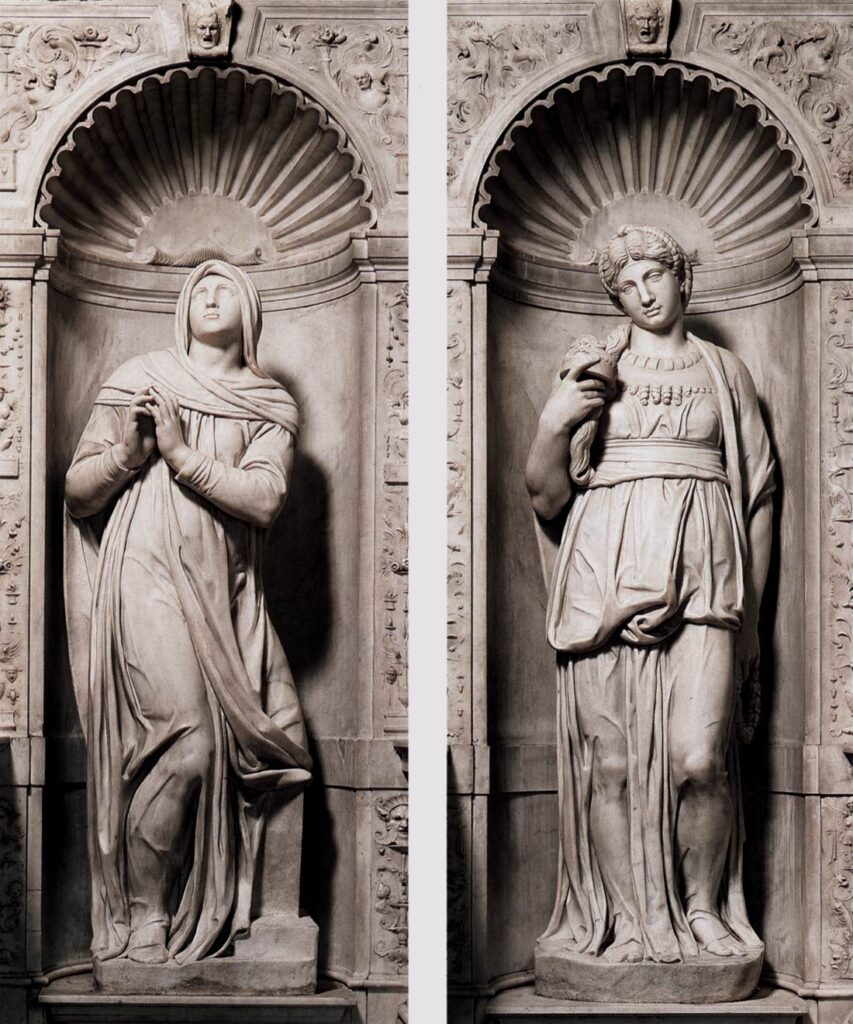
Rachel and Leah are two famous sculptures created by Michelangelo. They were part of the final design for the tomb of Pope Julius II in San Pietro in Vincoli. The sculptures depict Old Testament figures, with Rachel representing the contemplative life and Leah representing the active life.
Although created possibly at different times, they share some inconsistencies in their proportions. Both sculptures are allegories of Christianity and Old-Testament beliefs. Rachel is portrayed as a pensive figure sitting with her elbow on her knee while Leah is depicted as more active with one arm outstretched. These unique features make them stand out from other artworks of that time.
The tomb also includes Michelangelo’s central figure of Moses, which was completed around 1545. This exquisite work features an imposing statue of Moses seated on a high throne holding tablets bearing the Ten Commandments on his lap.
37. The Deposition (1547)
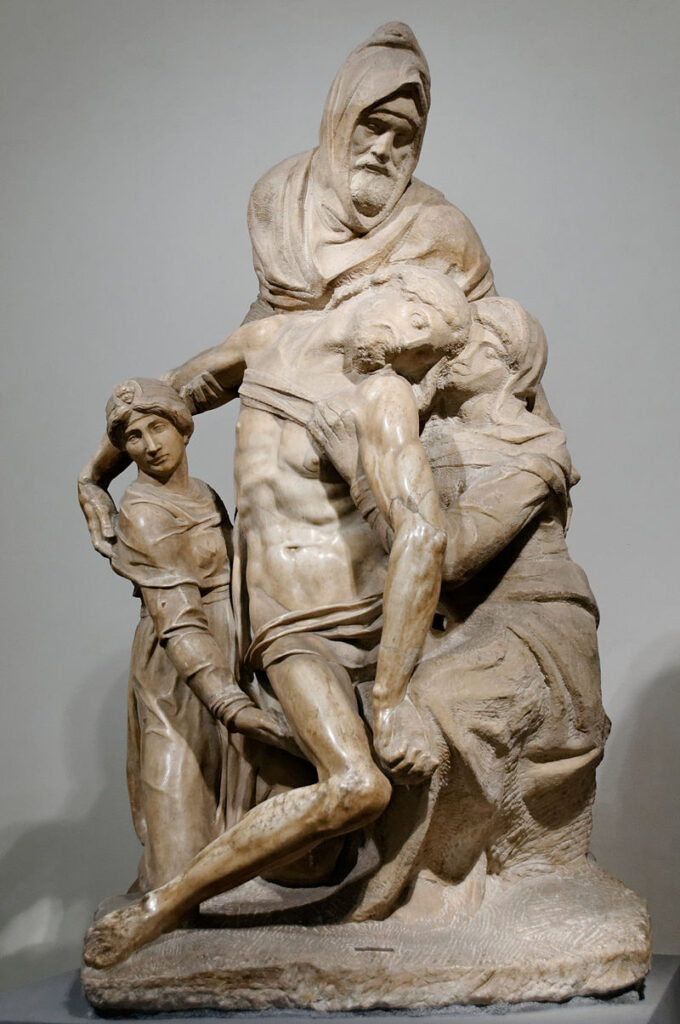
Michelangelo’s Deposition is a stunning marble sculpture created between 1547 and 1555. It features four figures carved from a large piece of marble, including the body of Christ lying in the foreground, supported by two figures. The fourth figure is Mary Magdalene, who holds one of Christ’s feet while Nicodemus applies oil to his wounded hands.
Michelangelo worked on The Deposition for seven years intermittently, as he intended to use it for his family tomb as a fitting memorial for himself and his loved ones. The sculpture presents Michelangelo’s talent in rendering human anatomy with great precision and expression that seemingly makes the marble come to life.
The museum that houses this magnificent art piece is the Museo dell’Opera del Duomo located in Florence, Italy. Four figures depicted on the sculpture include Jesus Christ’s dead body, Nicodemus, Mary Magdalene, and Virgin Mary. Despite its subject matter being quite somber – with Jesus’ lifeless body at its center – it still manages to be undeniably beautiful.
38. Rondanini Pieta (1564)
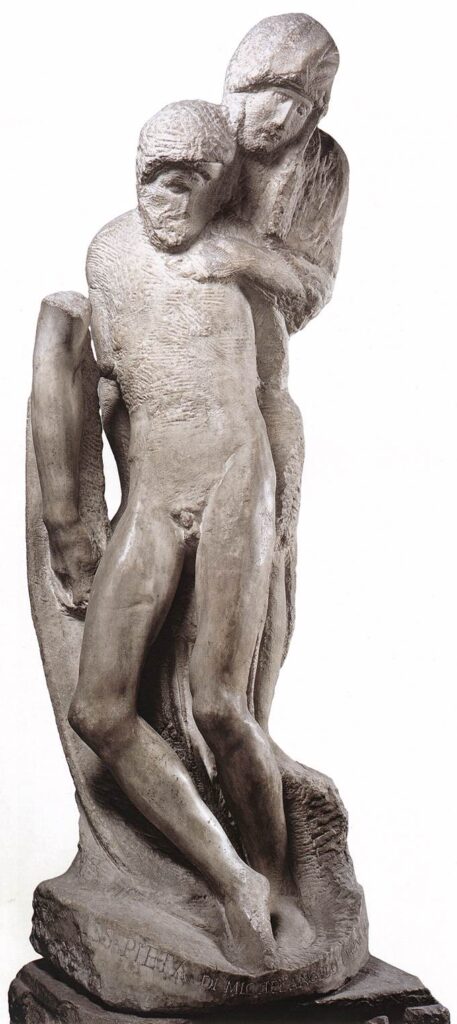
Michelangelo’s Rondanini Pietà is a marble sculpture that he worked on from 1552 until the last days of his life. This was actually the last version of the sculpture, which depicts an upright Jesus supported from behind by Mary. Located at the Castello Sforzesco in Milan, Italy, the sculpture stood for centuries in the courtyard at Palazzo Rondanini in Rome.
Considered one of Michelangelo’s most intriguing works of art, The Rondanini Pietà is his last sculpture. It engages the viewer in an embodied and temporal process of perceiving the becomings of sculpted form. This sculpture uses a novel approach to portray a moving and intense deposition of the dead Christ compared to Michelangelo’s earlier sculptures.
The theme surrounding The Rondanini Pietà is death and salvation for the soul; it is Michelangelo’s testament and meditation about it. While there were three versions created by Michelangelo throughout his lifetime, this one stands out as not only being his last but also as a representation that signifies what he thought about death at such an old age.
39. Palestrina Pietà
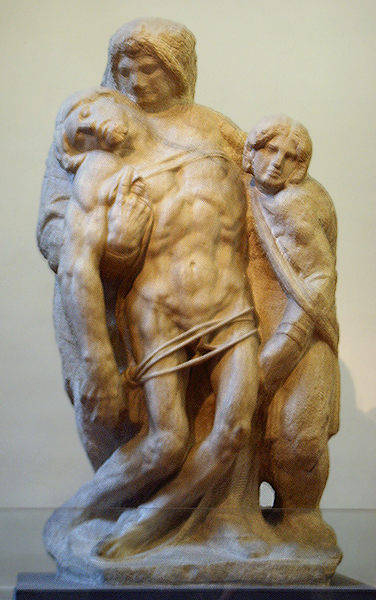
The Palestrina Pietà is a marble sculpture of the Italian Renaissance, which is now housed in the Galleria dell’Accademia in Florence. The statue features the Virgin Mary holding the body of Jesus after his crucifixion, commonly known as a Pietà sculpture. Although most scholars attribute this masterpiece to Michelangelo Buonarroti, some believe that it was completed by Niccolò Menghini or Gian Lorenzo Bernini. Despite debates over its creator, the Palestrina Pietà remains a significant artwork and testament to Renaissance art.
The statue stands at 5 feet 8 inches tall and was carved out of a single block of marble selected by Michelangelo himself from Carrara quarries. This particular work was intended to adorn Cardinal Jean de Bilhères’s chapel of Santa Petronilla in the Vatican City. He had been an ambassador for King Louis XII of France before becoming Pope Julius II’s treasurer.
Although many consider Michelangelo as its creator, some art experts see unusual proportions and graceful carvings that differ from Michelangelo’s style. Regardless, it remains an important artwork representing religious themes during the Italian Renaissance period.
40. Pietà (c. 1550)
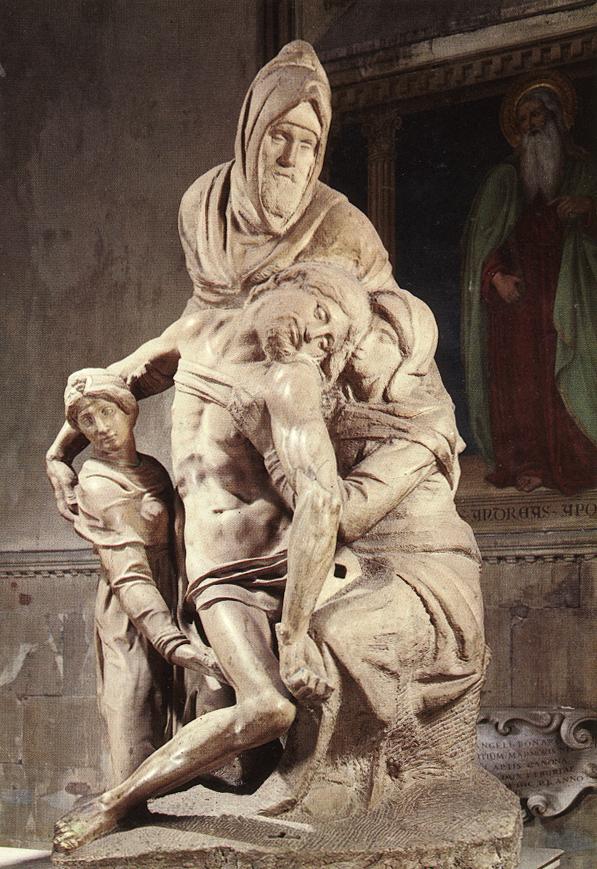
Michelangelo’s famous sculpture, the Pietà, is a masterpiece of Renaissance art. It depicts the Virgin Mary holding the body of her son Jesus Christ after his crucifixion, representing her sorrow and compassion. This beautiful work of art is made from a single slab of Carrara marble and can be found in St. Peter’s Basilica in Vatican City.
Commissioned by a French Cardinal living in Rome, Michelangelo worked tirelessly to create this 174cm high sculpture between 1498-1499 when he was only 24 years old. Despite having been attacked in 1972 by an unstable geologist hammering pieces off it while shouting “I am Jesus Christ!”, it has since been restored and remains one of Michelangelo’s most recognizable works.
The Pietà is widely regarded as one of the world’s greatest sculptures because of its incredible detail, depiction of the human form, and emotional intensity. The draperies that Michelangelo carved so delicately around Mary give an almost illusionary effect as if they were fabric instead of stone! Michelangelo also paid particular attention to naturalistic form during his creation process. In addition to his brilliant career as a painter (i.e., ‘Last Judgment’ on Sistine chapel), Michelangelo demonstrated true mastery through this exceptional sculpture!
